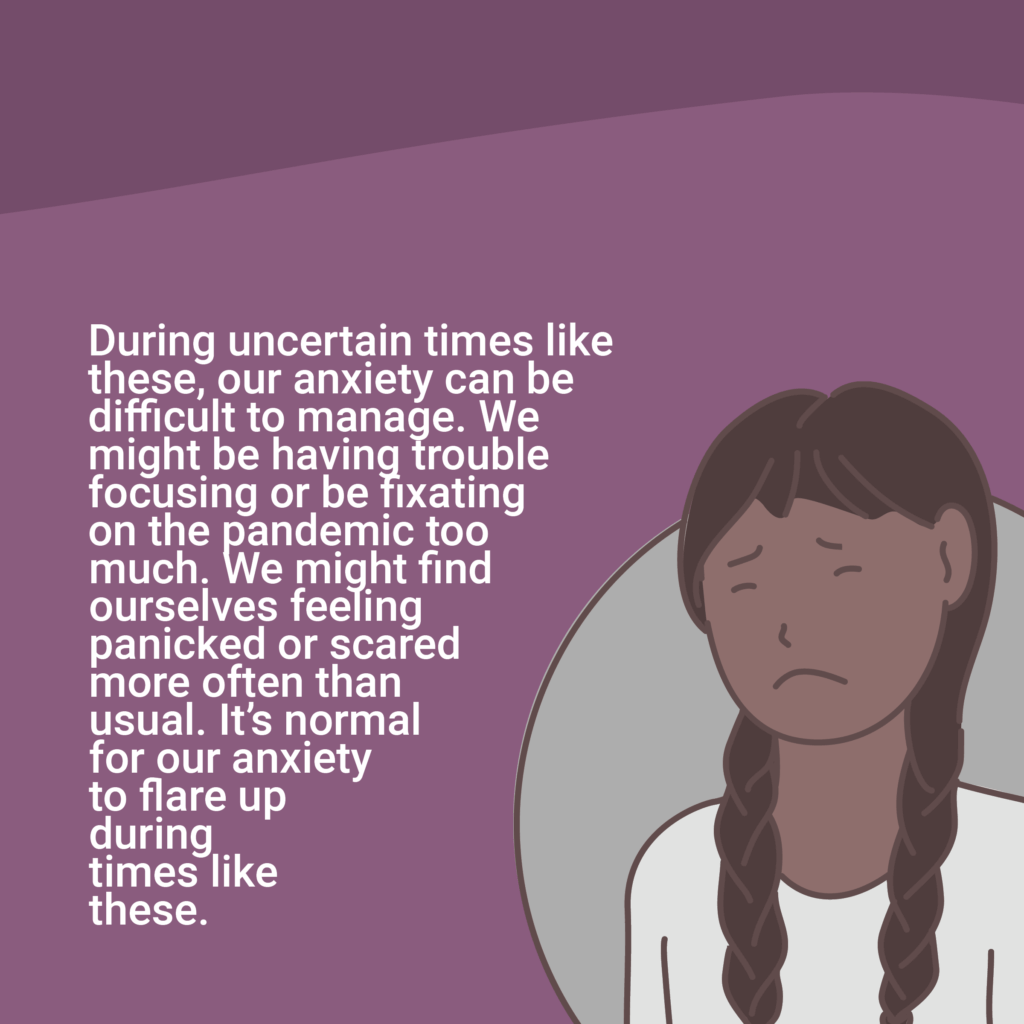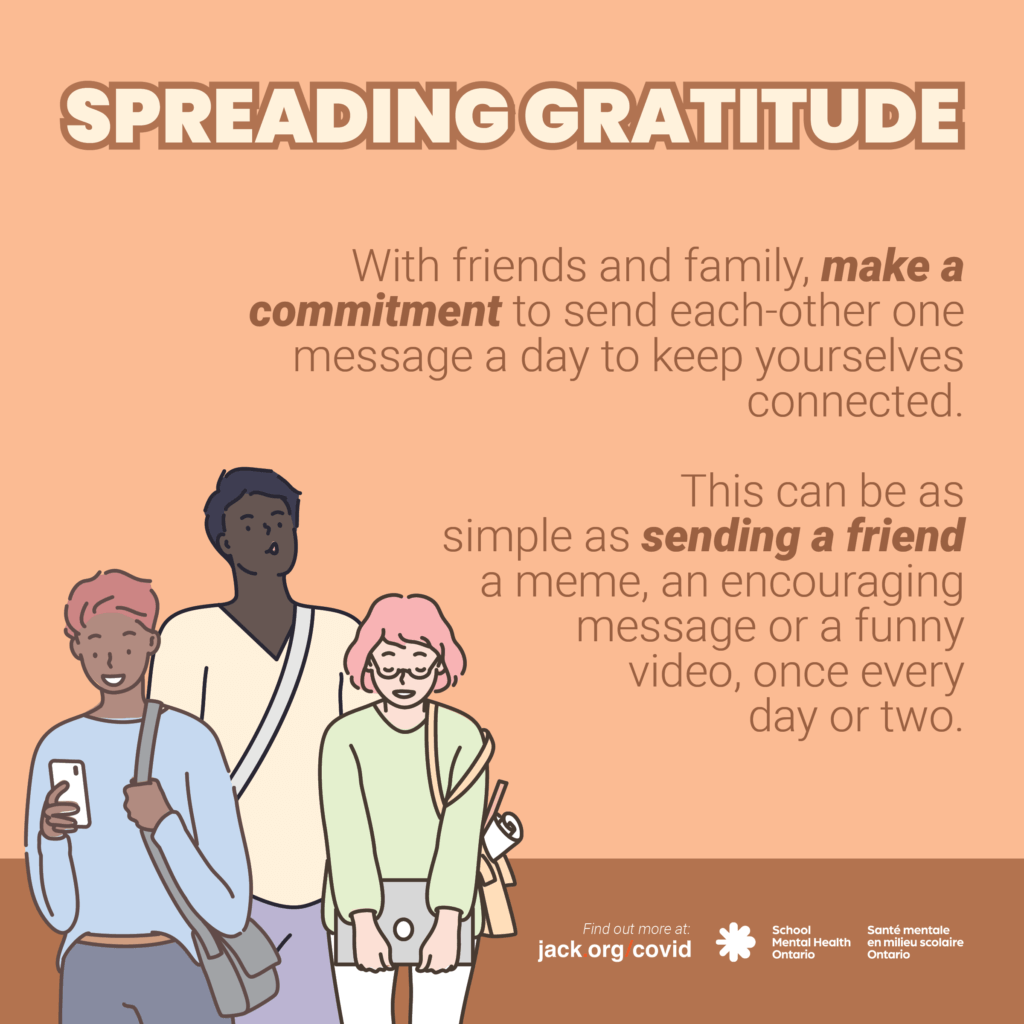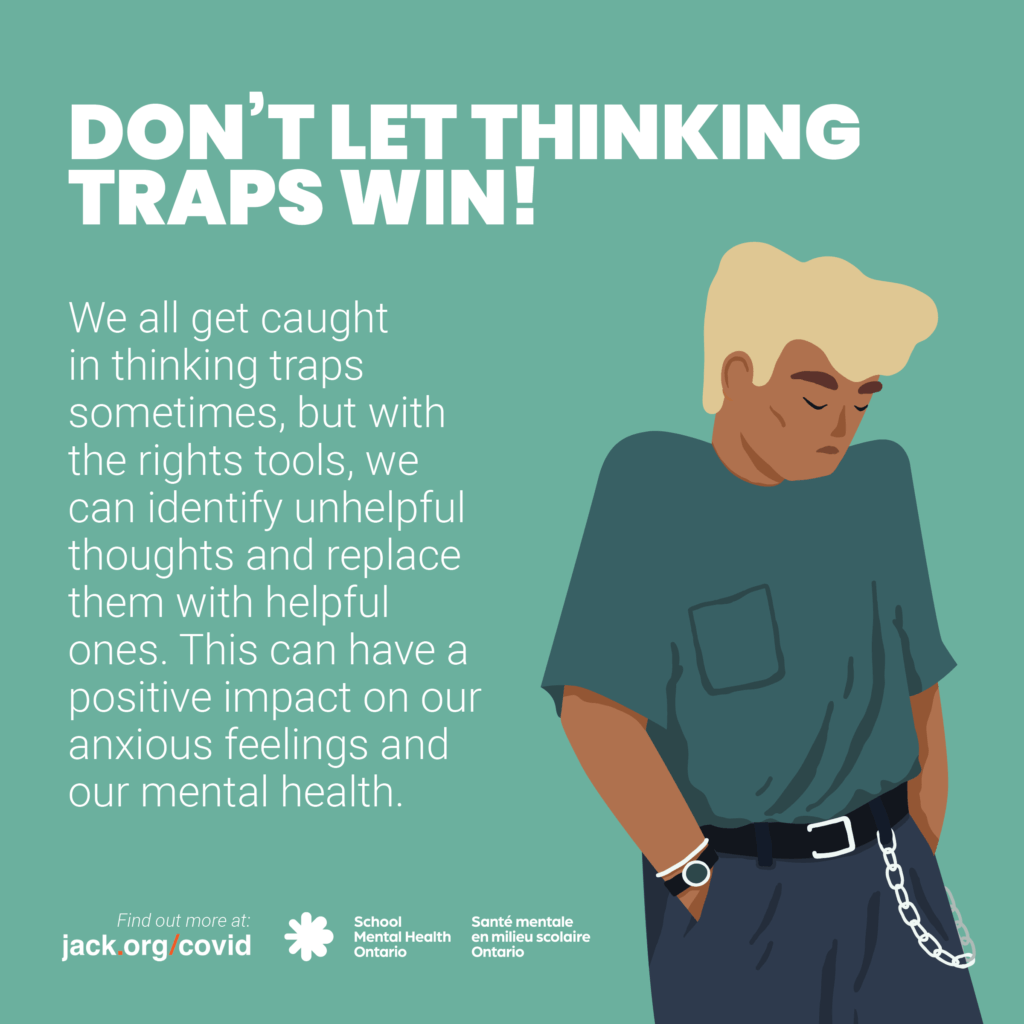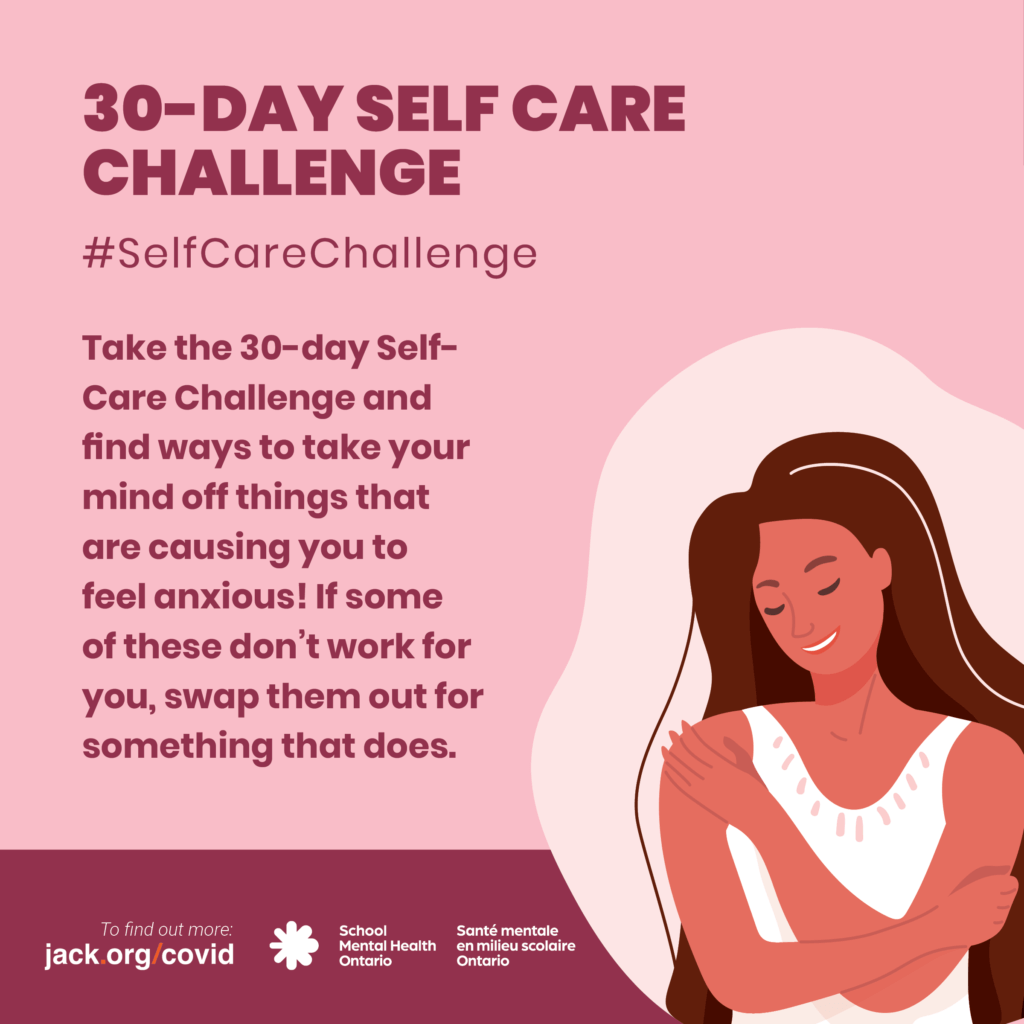Mental Health Literacy and Anxiety Management Social Media Bundles
It’s normal to feel anxious during challenging times. With the help of Ontario secondary school students, we’ve put together youth-friendly materials for the classroom, or to share via social media, to help students understand more about anxiety and coping in relation to the pandemic.
Mental health literacy
Download the complete mental health literacy bundle (zip file)
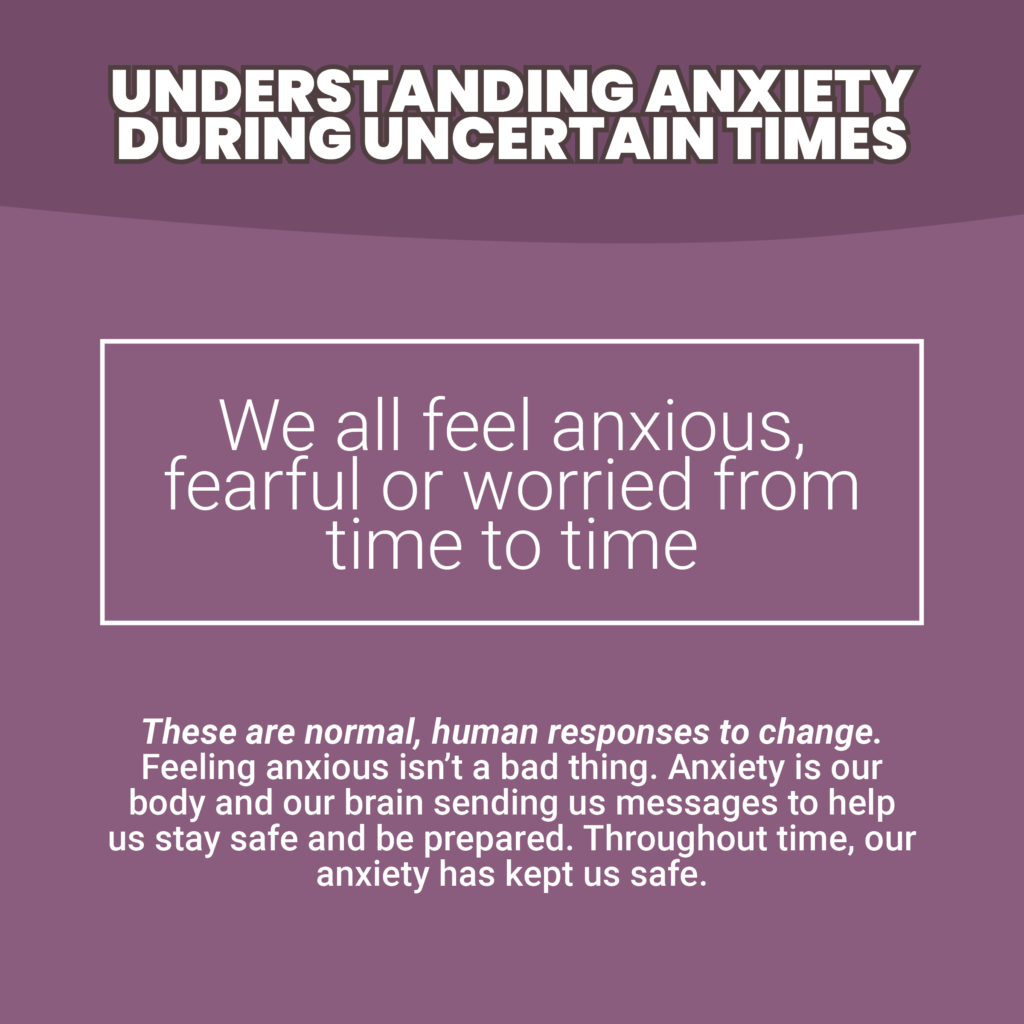
We all feel anxious, fearful or worried from time to time.
These are normal, human responses to change.
Feeling anxious isn’t a bad thing. Anxiety is our body and our brain sending us messages to help us stay safe and be prepared. Throughout time, our anxiety has kept us safe.
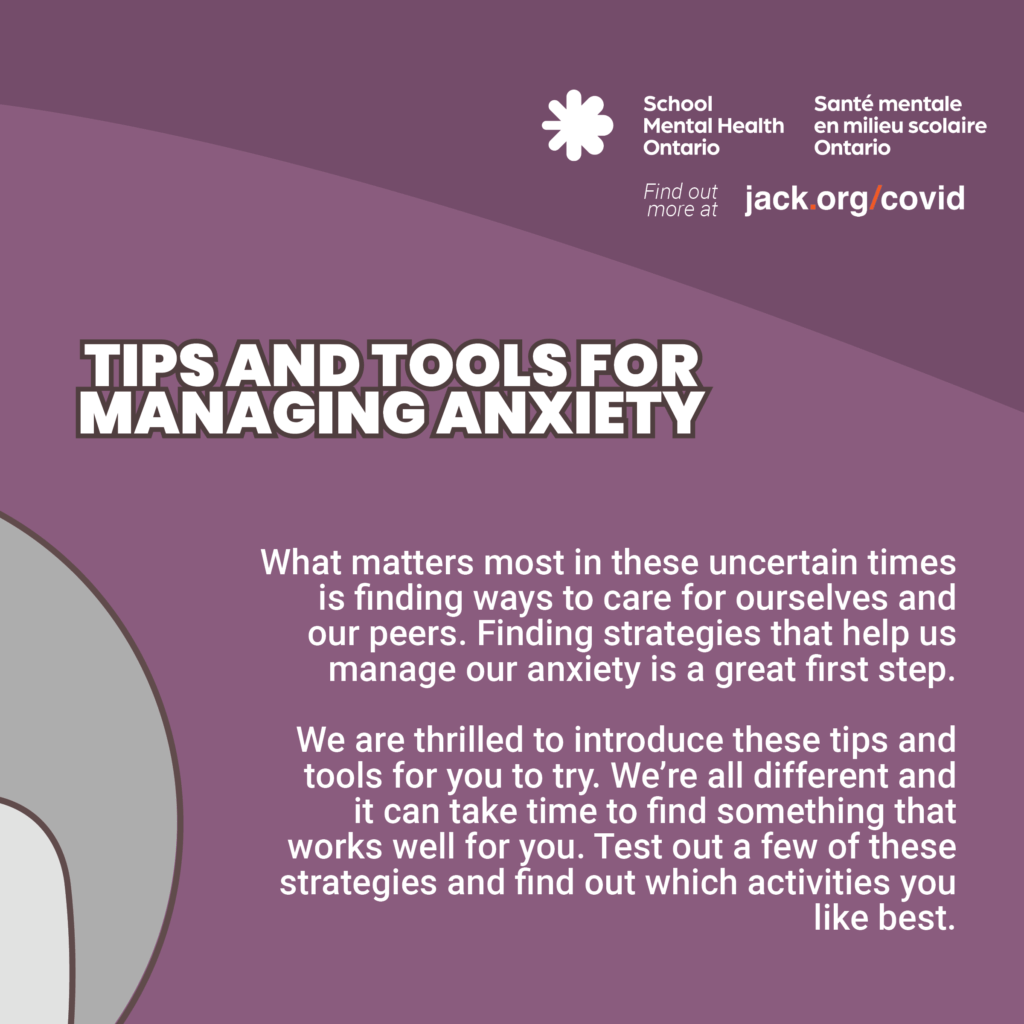
Tips and tools for managing anxiety
What matters most in these uncertain times is finding ways to care for ourselves and our peers. Finding strategies that help us manage our anxiety is a great first step.
We are thrilled to introduce these tips and tools for you to try. We’re all different and it can take time to find something that works well for you. Test out a few of these strategies and find out which activities you like best.
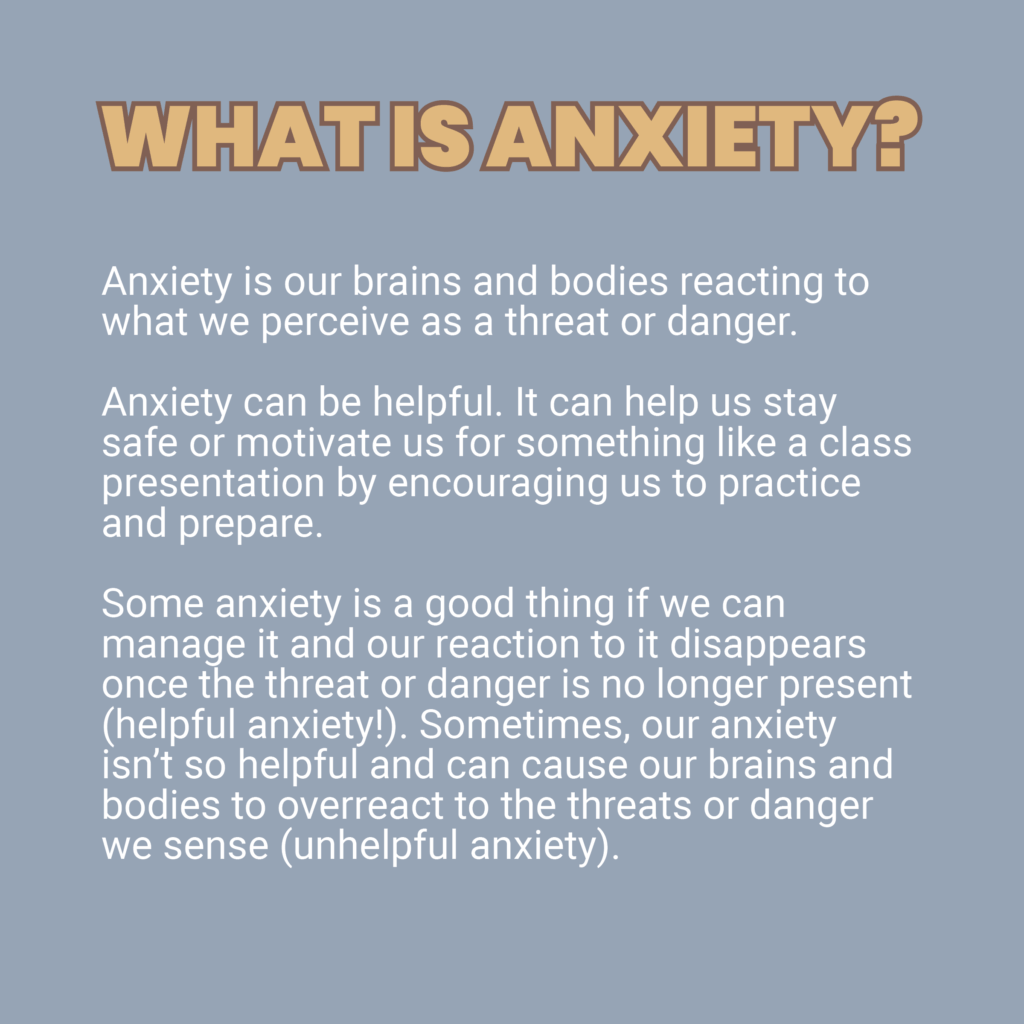
What is anxiety?
Anxiety is our brains and bodies reacting to what we perceive as a threat or danger.
Anxiety can be helpful. It can help us stay safe or motivate us for something like a class presentation by encouraging us to practice and prepare.
Some anxiety is a good thing if we can manage it and our reaction to it disappears once the threat or danger is no longer present (helpful anxiety!). Sometimes, our anxiety isn’t so helpful and can cause our brains and bodies to overreact to the threats or danger we sense (unhelpful anxiety).
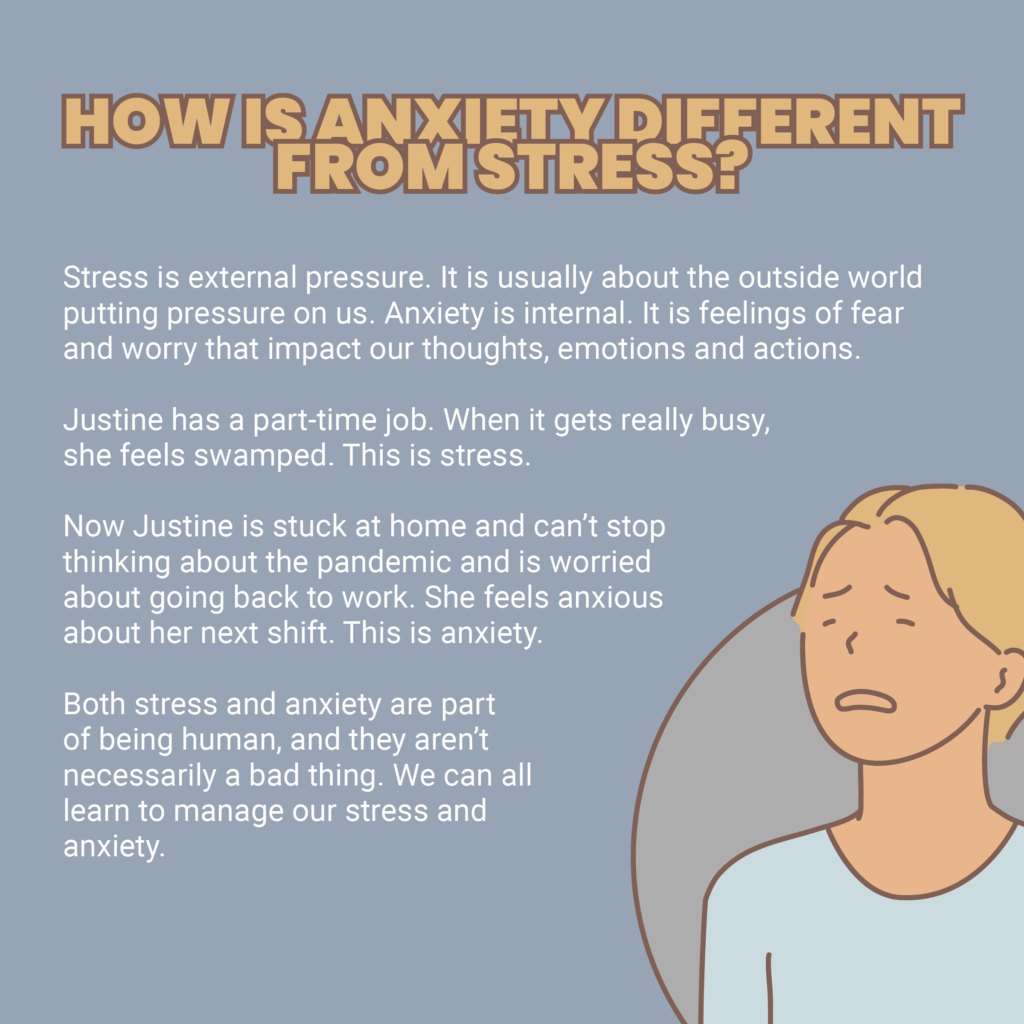
How is anxiety different from stress?
Stress is external pressure. It is usually about the outside world putting pressure on us. Anxiety is internal. It is feelings of fear and worry that impact our thoughts, emotions and actions.
Justine has a part-time job. When it gets really busy, she feels swamped. This is stress.
Now Justine is stuck at home and can’t stop thinking about the pandemic and is worried about going back to work. She feels anxious about her next shift. This is anxiety.
Both stress and anxiety are part of being human, and they aren’t necessarily a bad thing. We can all learn to manage our stress and anxiety.
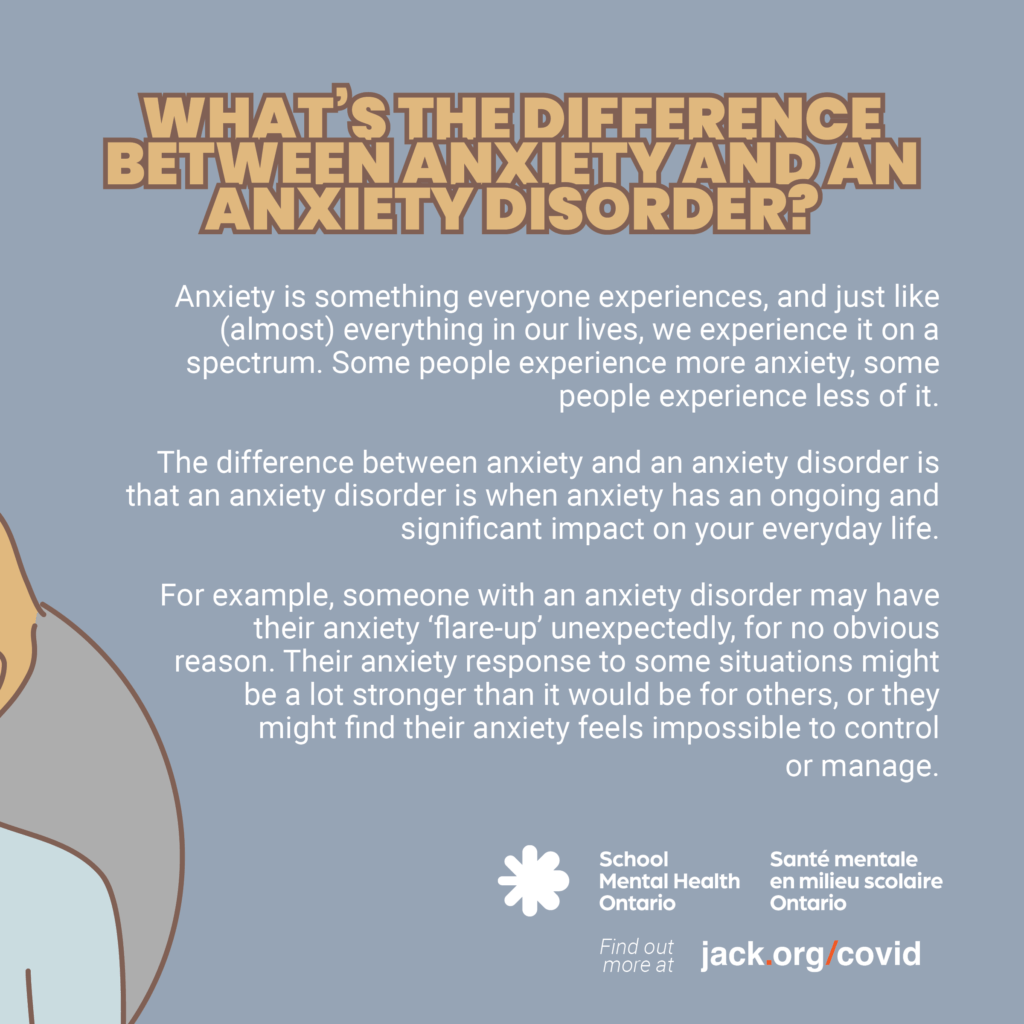
What’s the difference between anxiety and an anxiety disorder?
Anxiety is something everyone experiences, and just like (almost) everything in our lives, we experience it on a spectrum. Some people experience more anxiety, some people experience less of it.
The difference between anxiety and an anxiety disorder is that an anxiety disorder is when anxiety has an ongoing and significant impact on your everyday life.
For example, someone with an anxiety disorder may have their anxiety ‘flare-up’ unexpectedly, for no obvious reason. Their anxiety response to some situations might be a lot stronger than it would be for others, or they might find their anxiety feels impossible to control or manage.
Breathing exercises
Download the complete breathing exercises bundle (zip file)
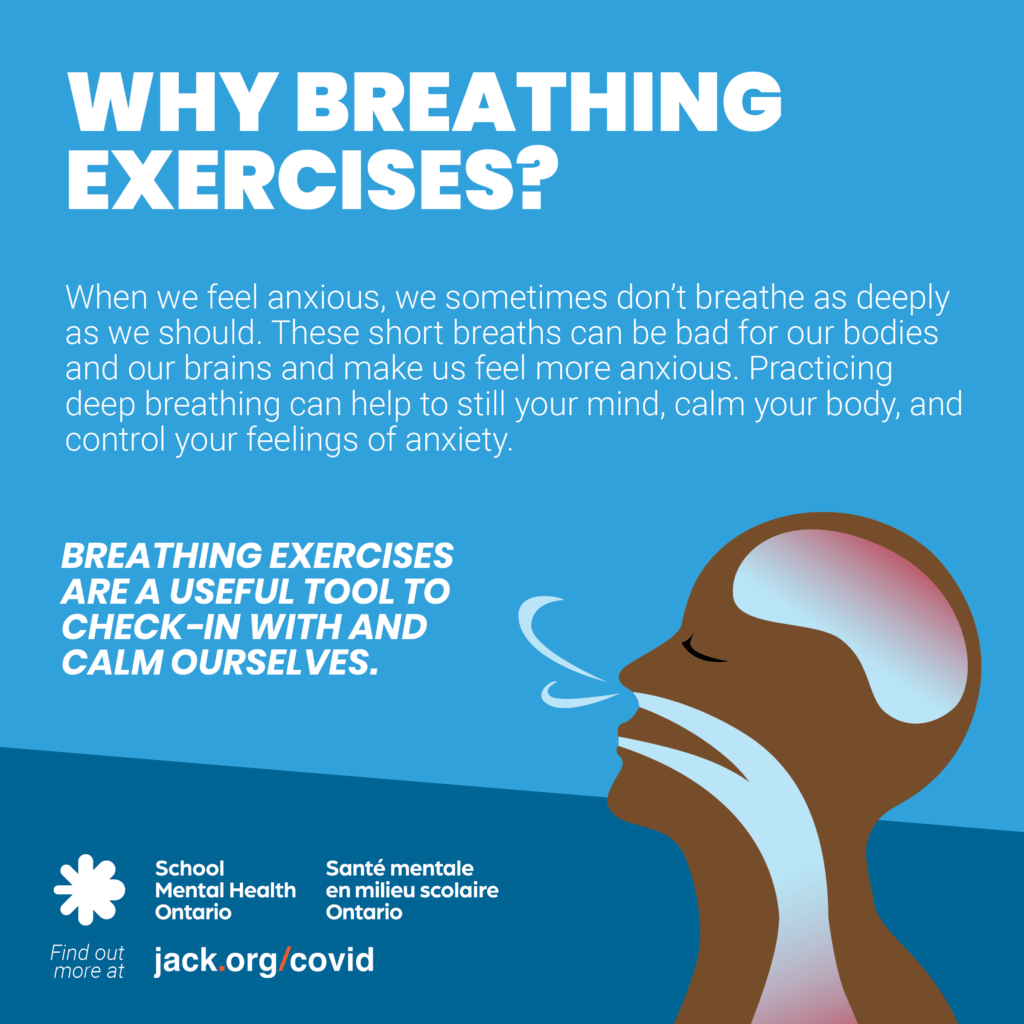
Why breathing exercises?
When we feel anxious, we sometimes don’t breathe as deeply as we should. These short breaths can be bad for our bodies and our brains and make us feel more anxious. Practicing deep breathing can help to still your mind, calm your body, and control your feelings of anxiety.
Breathing exercises are a useful tool to check-in with and calm ourselves.
Circular Breathing Exercise – Descriptive Transcript
TEXT ON SCREEN: Take a deep breath. Hold it in for four seconds. Slowly breathe out. Focus on your breathing. As you’re breathing in and out, find:
TEXT ON SCREEN: five things you can see.
Five pairs of eye emojis appear. The eyes slowly move around. The eyes fade out.
TEXT ON SCREEN: four things you can touch.
Four hand emojis appear. The hands slowly move around. The hands fade out.
TEXT ON SCREEN: Three things you can hear.
Three ear emojis appear. The ears slowly move around. The ears fade out.
TEXT ON SCREEN: Two things you can smell.
Two nose emojis appear. The noses slowly move around. The noses fade out.
TEXT ON SCREEN: One thing you can taste.
One tongue emoji appears. The tongue slowly moves around. The tongue fades out.
TEXT ON SCREEN: Repeat as needed.
LOGO: School Mental Health Ontario.
TEXT ON SCREEN: Find out more at jack dot org forward-slash covid
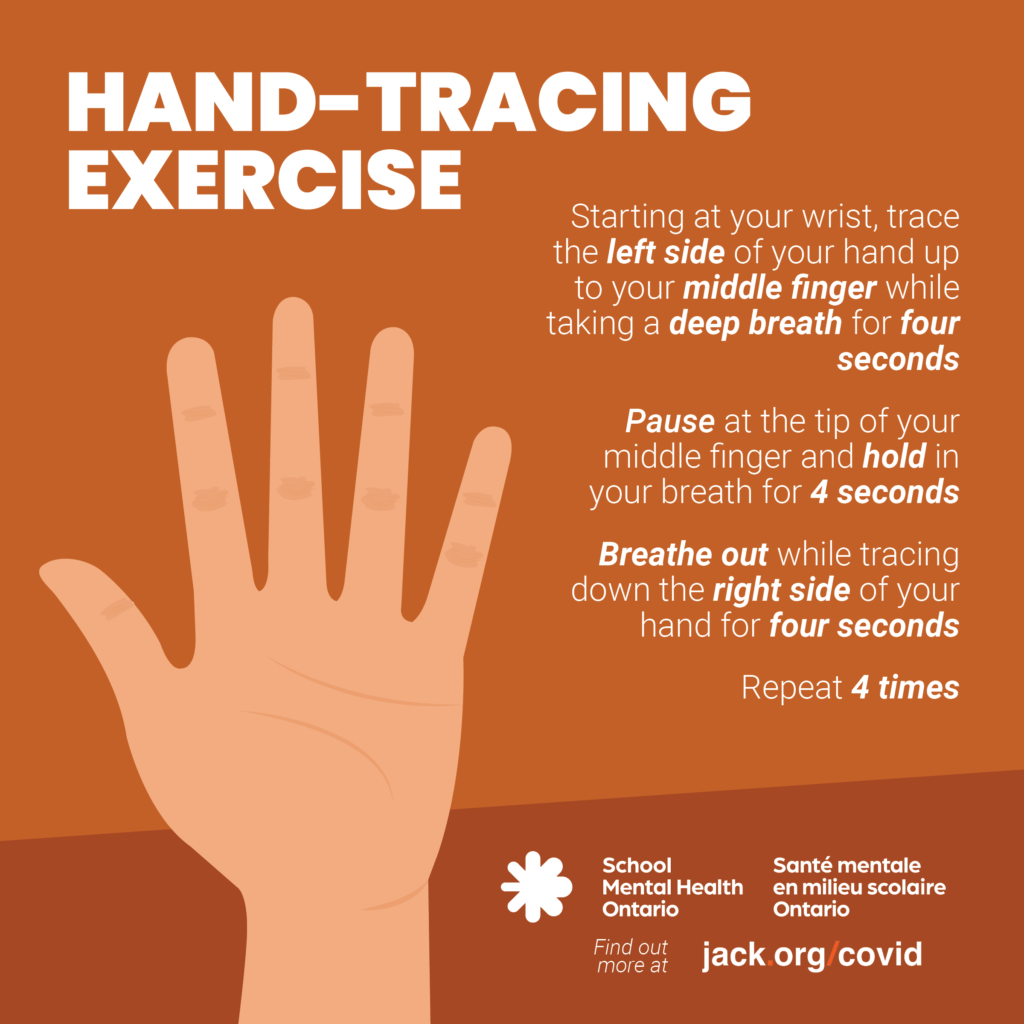
Hand-tracing exercise
Starting at your wrist, trace the left side of your hand up to your middle finger while taking a deep breath for four seconds.
Pause at the tip of your middle finger and hold in your breath for 4 seconds.
Breathe out while tracing down the right side of your hand for four seconds.
Repeat 4 times.
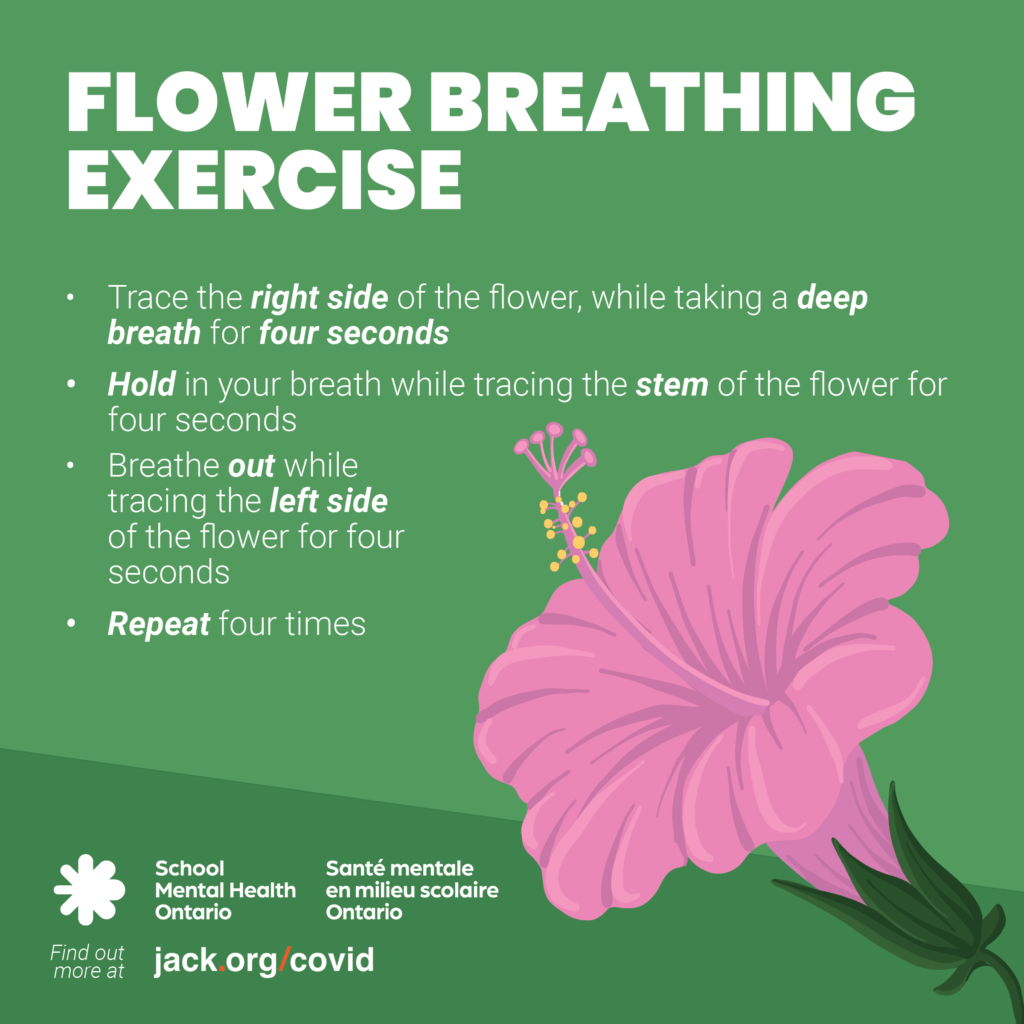
Flower breathing exercise
The image contains a large pink flower with a green stem.
Trace the right side of the flower, while taking a deep breath for four seconds.
Hold in your breath while tracing the stem of the flower for four seconds.
Breathe out while tracing the left side of the flower for four seconds.
Repeat four times.

Belly breathing exercise
In a sitting position, put one hand on your chest, and one hand on your belly.
Take a deep breath through your nose. Feel the air moving through your lungs. Slowly exhale from your mouth.
Take a second breath. Imagine bringing the air into your belly. See if you can make your belly move more than your chest.
Breathe in for four seconds. Hold the air in for four seconds. Feel the movement of the air in your belly. Breath out slowly for four seconds.
Repeat.
Circular Breathing Exercise – Descriptive Transcript
TEXT ON SCREEN: Take a deep breath. Hold it in for four seconds. Slowly breathe out. Focus on your breathing. As you’re breathing in and out, find:
TEXT ON SCREEN: five things you can see.
Five pairs of eye emojis appear. The eyes slowly move around. The eyes fade out.
TEXT ON SCREEN: four things you can touch.
Four hand emojis appear. The hands slowly move around. The hands fade out.
TEXT ON SCREEN: Three things you can hear.
Three ear emojis appear. The ears slowly move around. The ears fade out.
TEXT ON SCREEN: Two things you can smell.
Two nose emojis appear. The noses slowly move around. The noses fade out.
TEXT ON SCREEN: One thing you can taste.
One tongue emoji appears. The tongue slowly moves around. The tongue fades out.
TEXT ON SCREEN: Repeat as needed.
LOGO: School Mental Health Ontario.
TEXT ON SCREEN: Find out more at jack dot org forward-slash covid
Muscle relaxation exercises
Download the complete muscle relaxation exercises bundle (zip file)
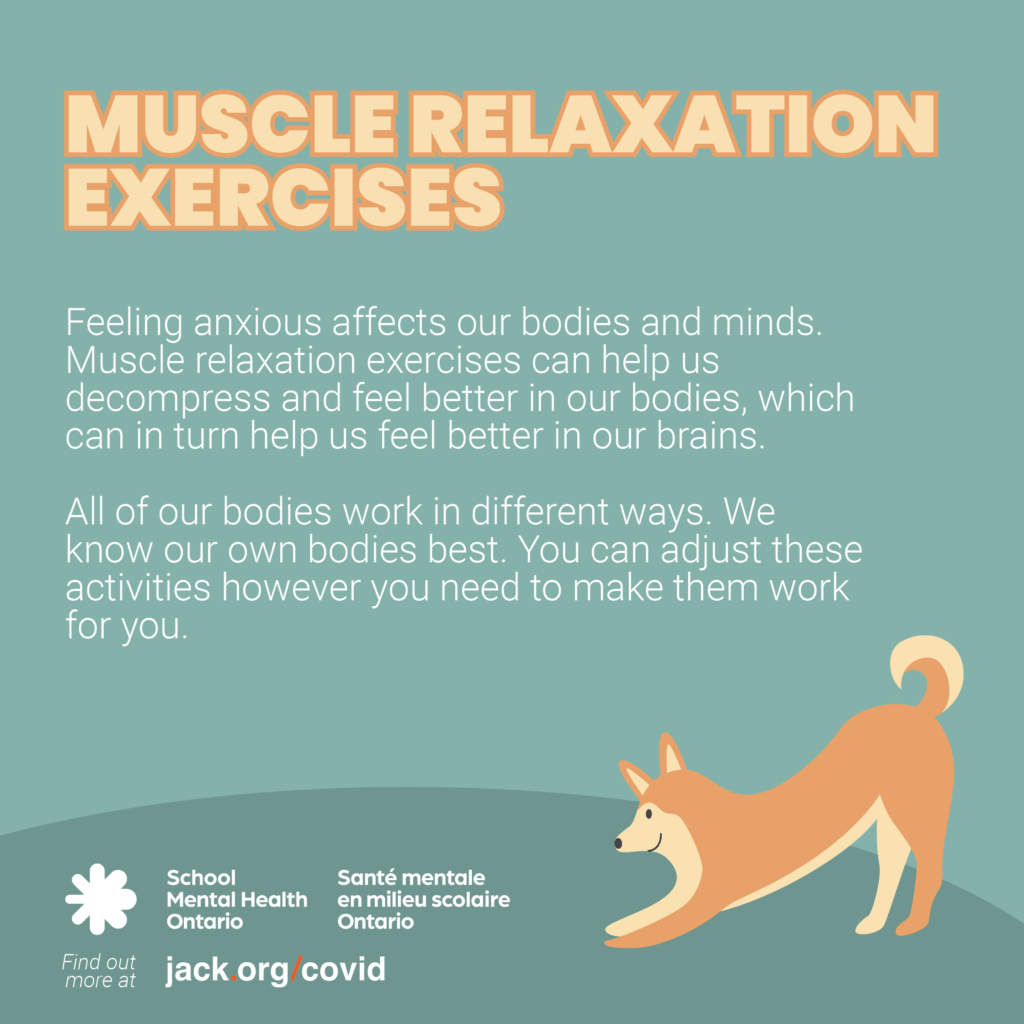
Muscle relaxation exercises
Feeling anxious affects our bodies and minds. Muscle relaxation exercises can help us decompress and feel better in our bodies, which can in turn help us feel better in our brains.
All of our bodies work in different ways. We know our own bodies best. You can adjust these activities however you need to make them work for you.
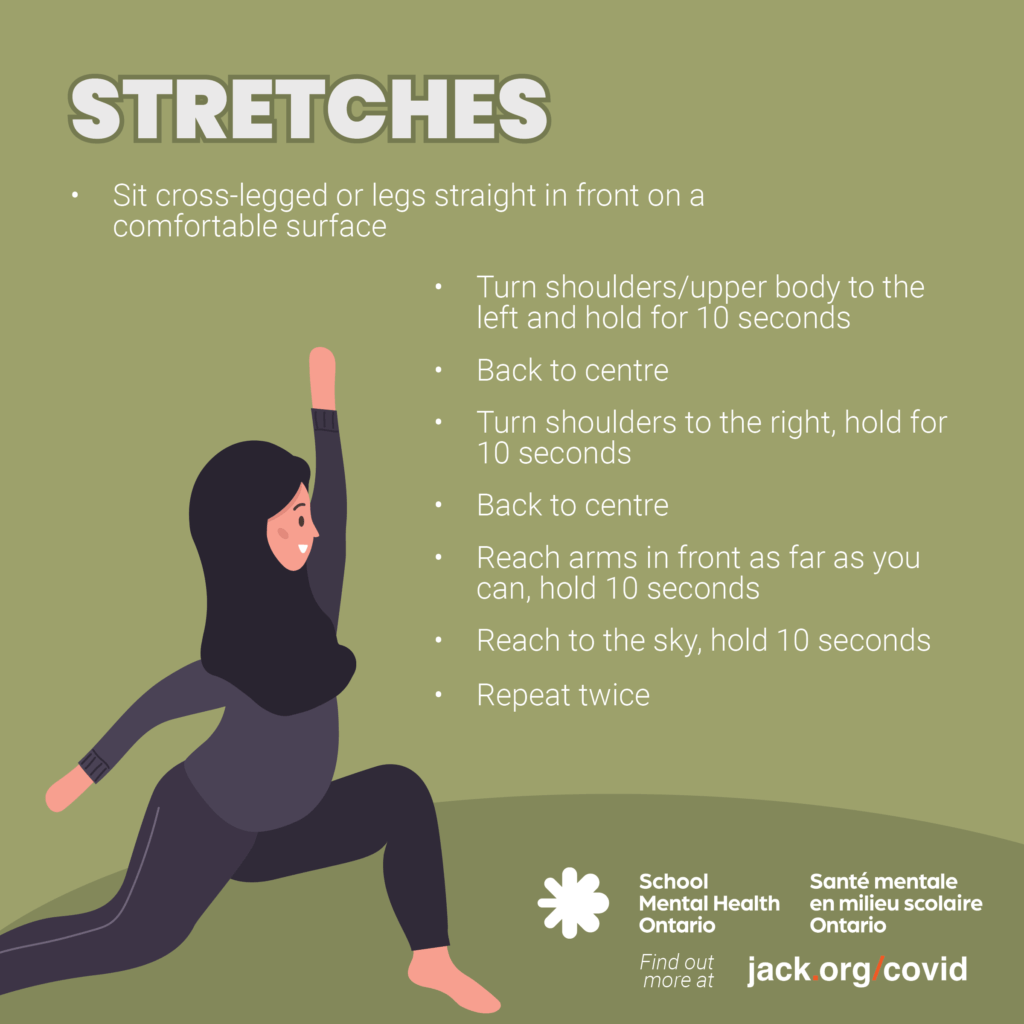
Stretches
Sit cross-legged or legs straight in front on a comfortable surface.
Turn shoulders/upper body to the left and hold for 10 seconds.
Back to centre.
Turn shoulders to the right, hold for 10 seconds.
Back to centre.
Reach arms in front as far as you can, hold 10 seconds.
Reach to the sky, hold 10 seconds
Repeat twice
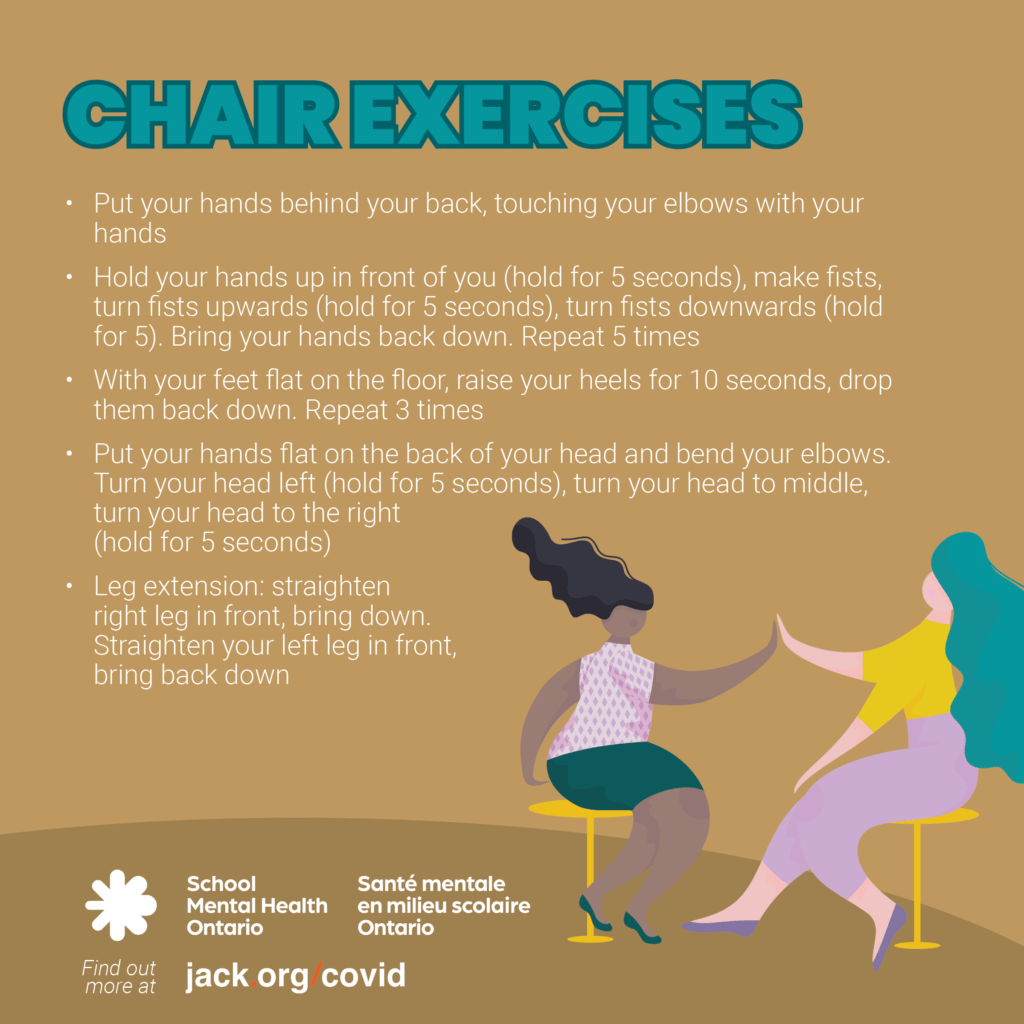
Chair exercises
Put your hands behind your back, touching your elbows with your hands.
Hold your hands up in front of you (hold for 5 seconds), make fists, turn fists upwards (hold for 5 seconds), turn fists downwards (hold for 5). Bring your hands back down. Repeat 5 times
With your feet flat on the floor, raise your heels for 10 seconds, drop them back down. Repeat 3 times
Put your hands flat on the back of your head and bend your elbows. Turn your head left (hold for 5 seconds), turn your head to middle, turn your head to the right (hold for 5 seconds).
Leg extension: straighten right leg in front, bring down. Straighten your left leg in .
Gratitude exercises
Download the complete gratitude exercises bundle (zip file)
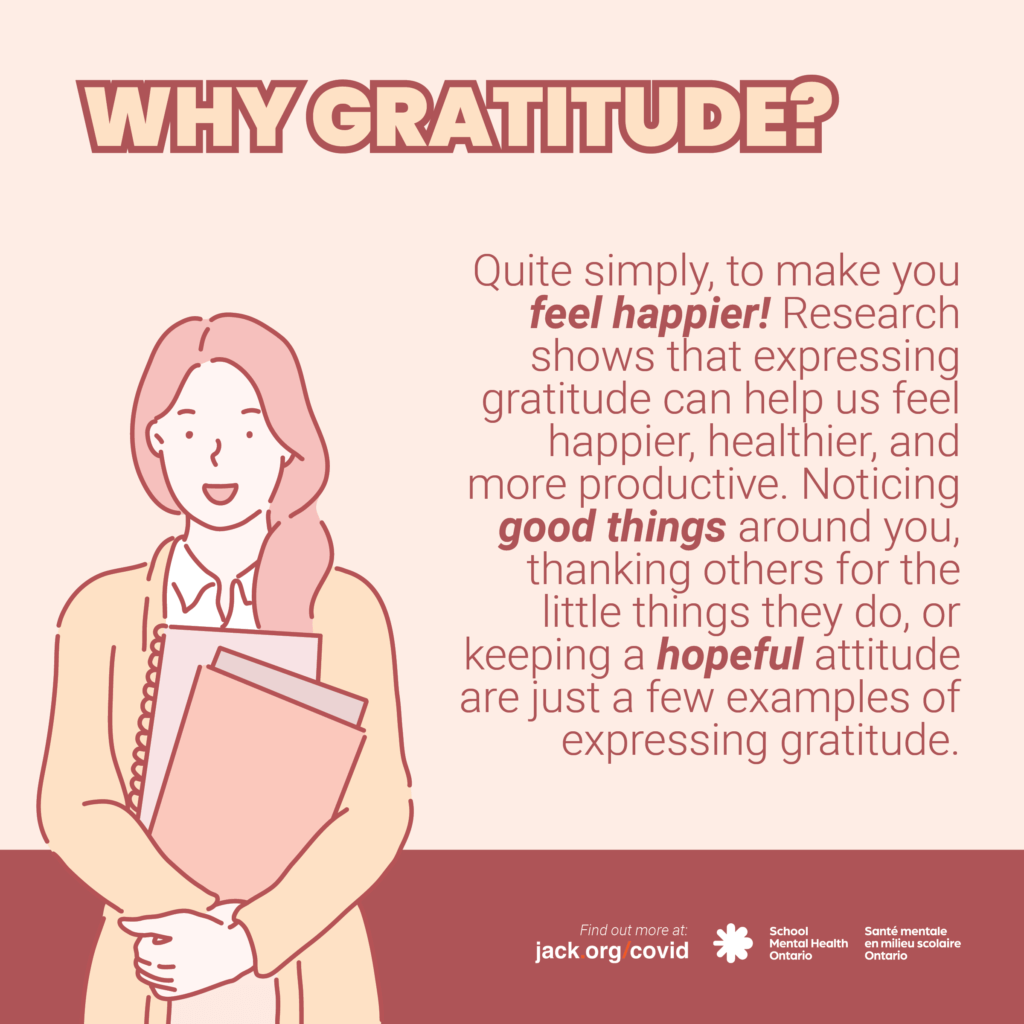
Why gratitude?
Quite simply, to make you feel happier! Research shows that expressing gratitude can help us feel happier, healthier, and more productive. Noticing good things around you, thanking others for the little things they do, or keeping a hopeful attitude are just a few examples of expressing gratitude.
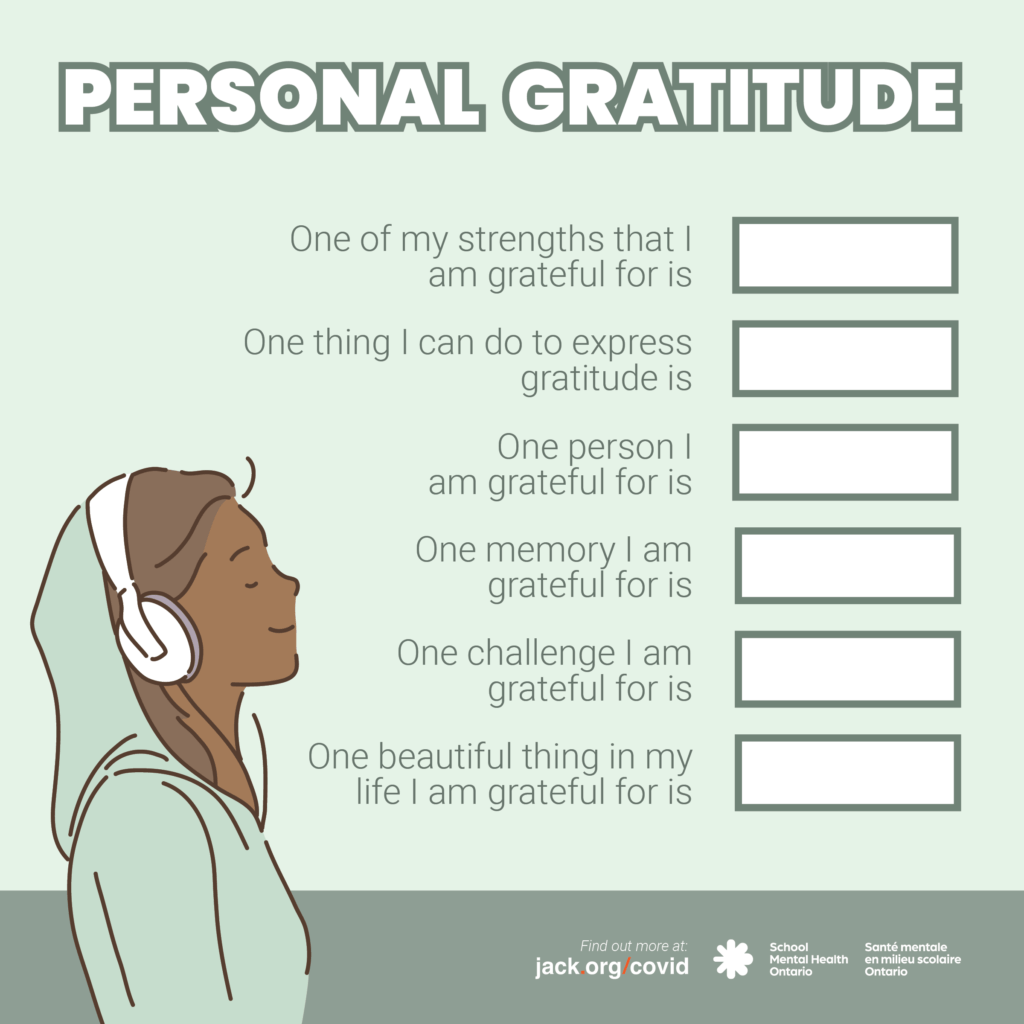
Personal gratitude
Take a moment to complete each of the following statements.
One of my strengths that I am grateful for is…
One thing I can do to express gratitude is…
One person I am grateful for is…
One memory I am grateful for is…
One challenge I am grateful for is…
One beautiful thing in my life I am grateful for is…
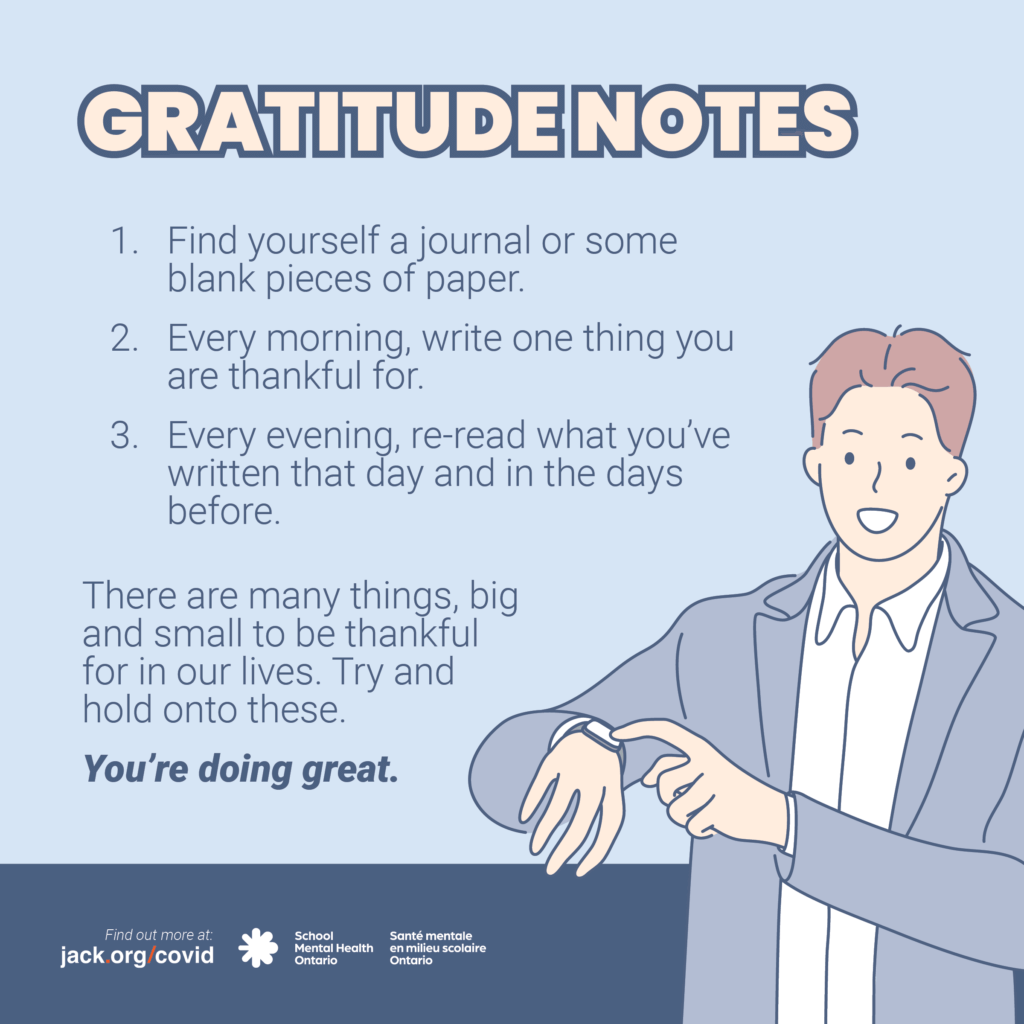
Gratitude Notes
Find yourself a journal or some blank pieces of paper.
Every morning write one thing you are thankful for.
Every evening, re-read what you’ve written that day and in the days before.
There are many things, big and small to be thankful for in our lives. Try and hold onto these.
You’re doing great.

Gratitude Reminders
It’s important to remind ourselves to be grateful for the good things in our lives and the good things we bring into the lives of those around us. If you’re feeling down and in need of a little boost, check out the following list to see if anything jumps out at you! Try it out – say it out loud. Say it a few more times. Think about how it makes you feel stronger. You got this.
I am capable
I am valuable
I am enough
I am a good person
I deserve love
I deserve compassion
I deserve patience
I am doing the best I can
Thought-changing exercises
Download the complete thought-changing exercises bundle (zip file)
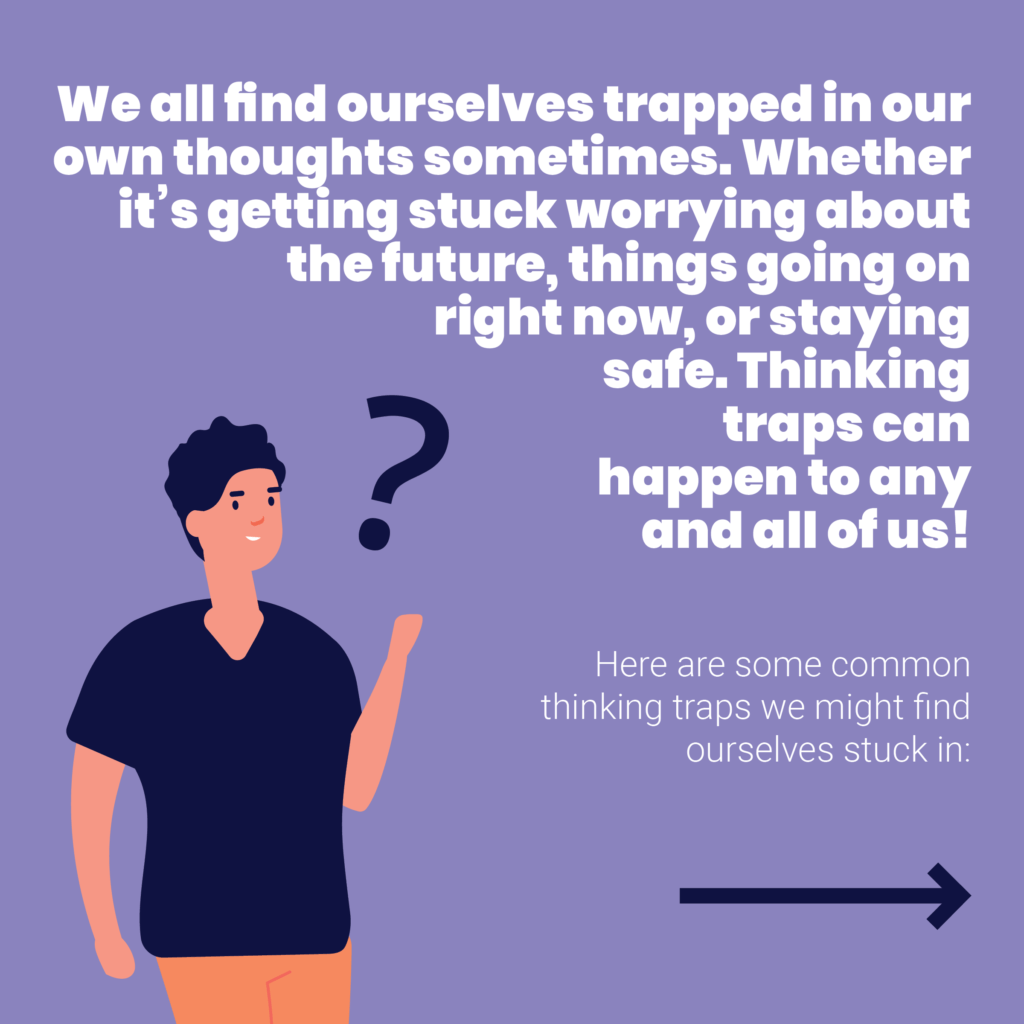
We all find ourselves trapped in our own thoughts sometimes. Whether it’s getting stuck worrying about the future, things going on right now, or staying safe. Thinking traps can happen to any and all of us.
Common thinking traps we might find ourselves stuck in are provided in the following image and related text.
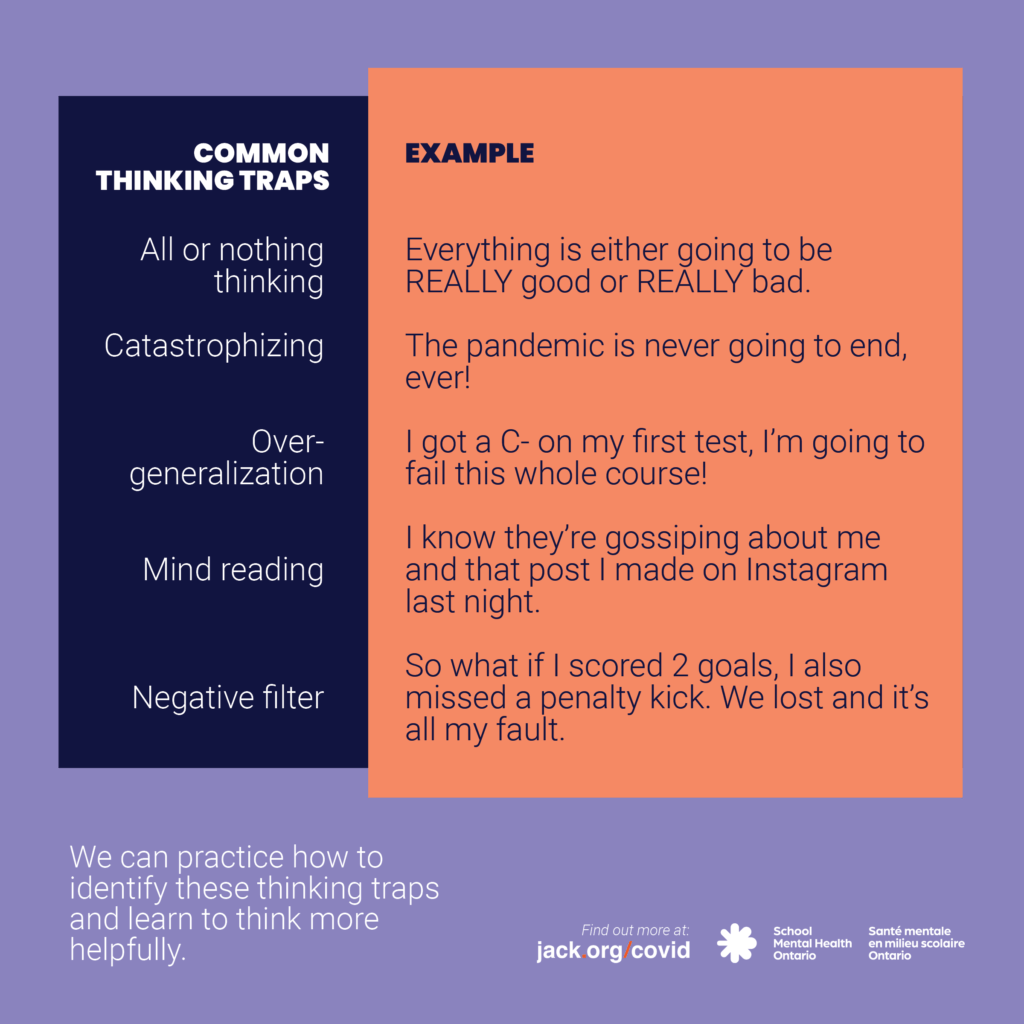
Here are some common thinking traps and examples:
Thinking trap: All or nothing thinking
Example: Everything is either going to be REALLY good or REALLY bad
Thinking trap: Catastrophizing
Example: The pandemic is never going to end, ever!
Thinking trap: Over-generalization
Example: I got a C- on my first test, I’m going to fail this whole course!
Thinking trap: Mind reading
Example: I know they’re gossiping about me and that post I made on Instagram last night.
Thinking trap: Negative filter
Example: So what if I scored 2 goals, I also missed a penalty kick. We lock and it’s all my fault.
We can practice how to identify these thinking traps and learn to think more helpfully.
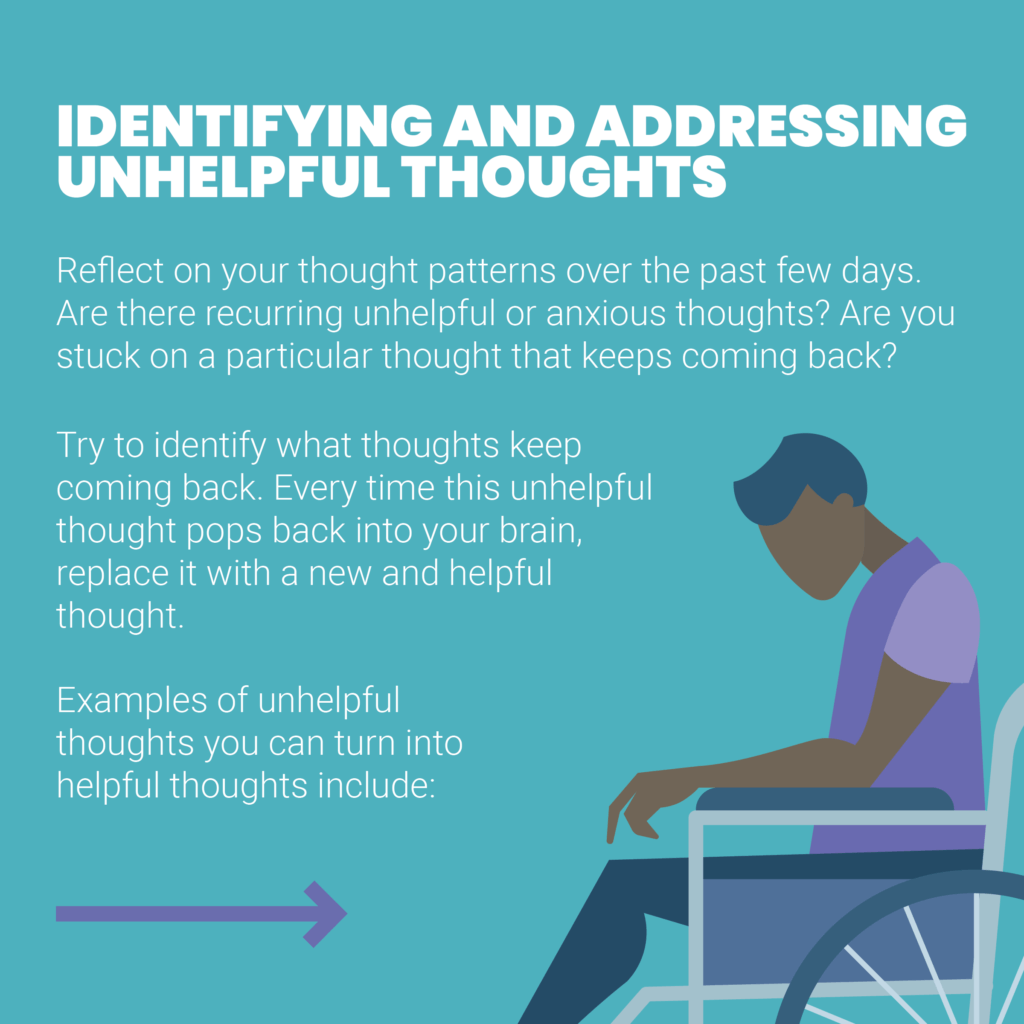
Identifying and addressing unhelpful thoughts
Reflect on your thought patterns over the past few days. Are there recurring negative or anxious thoughts? Are you stuck on a particular thought that keeps coming back?
Try to identify what thoughts keep coming back. Every time this unhelpful thought pops back into your brain, replace it with a new and positive thought.
Examples of negative thoughts you can turn into positive thoughts are shared on the following image and related text
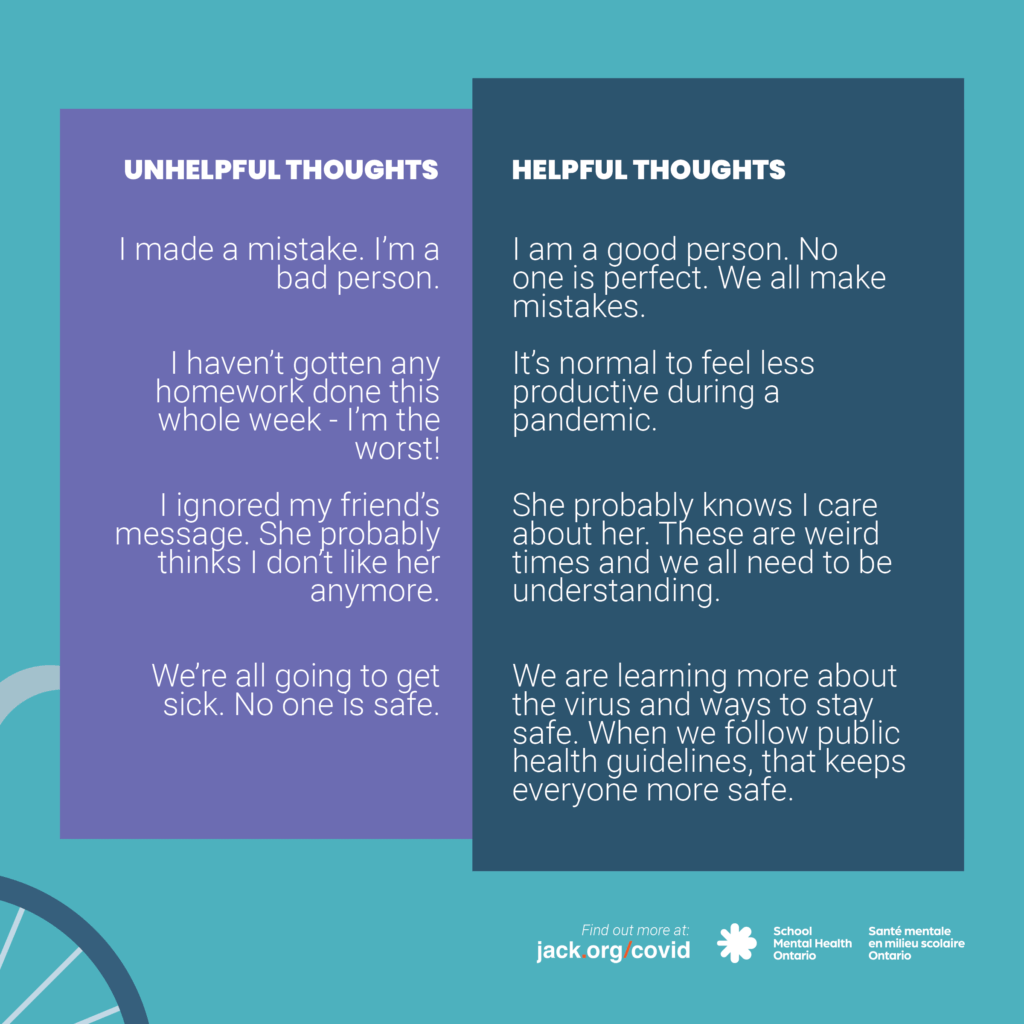
Here are some unhelp thoughts and examples on how to turn them into helpful thoughts.
Negative thought: I made a mistake. I’m a bad person.
Positive thoughts: I am a good person. No one is perfect. We all make mistakes.
Negative thought: I haven’t gotten any homework done this whole week – I’m the worst!
Positive thoughts: It’s normal to feel less productive during a pandemic.
Negative thought: I ignored my friend’s message. She probably thinks I don’t like her anymore.
Positive thoughts: She probably knows I care about her. These are weird times and we all need to be understanding.
Negative thought: We’re all going to get sick. No one is safe.
Positive thoughts: We are learning more about the virus and ways to stay safe. When we follow public health guidelines, that keeps everyone safer.
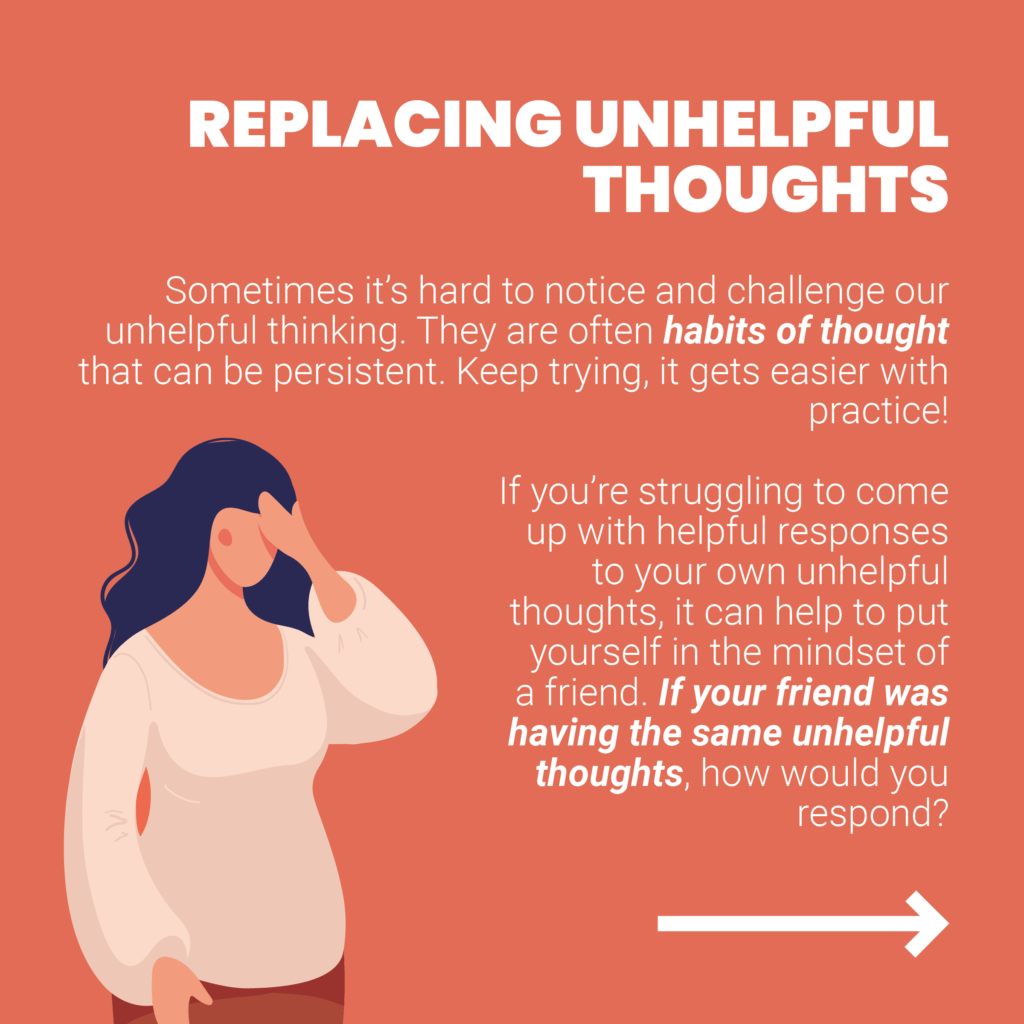
Replacing unhelpful thoughts
Sometimes it’s hard to notice and challenge our unhelpful thinking. They are often habits of through that can be persistent. Keep trying, it gets easier with practice!
If you’re struggling to come up with helpful responses to your own unhelpful thoughts, it can help to put yourself in the mindset of a friend. If your friend was having the same unhelpful thoughts, how would you respond?

Identifying unhelpful thoughts and replacing them with helpful ones can make a big difference. Write out, or think about, your unhelpful thoughts. Then, write out, or think about, helpful thoughts to replace them with.
For example:
Negative thought: I made a mistake. I’m a bad person.
Positive thought: I am a good person. No one is perfect. We all make mistakes.

Stop Negative Self-Talk
To stop negative self-talk, think of the acronym S-O-S.
S- stop! – When you have a negative thought, STOP and give yourself a moment to address the thought.
O- Observe – Reflect on what you’re saying. Think about where your thoughts are coming from.
S- Shift – Replace the thought with something positive. Shift your thinking.
Repeat this every time you have a recurring negative thought.
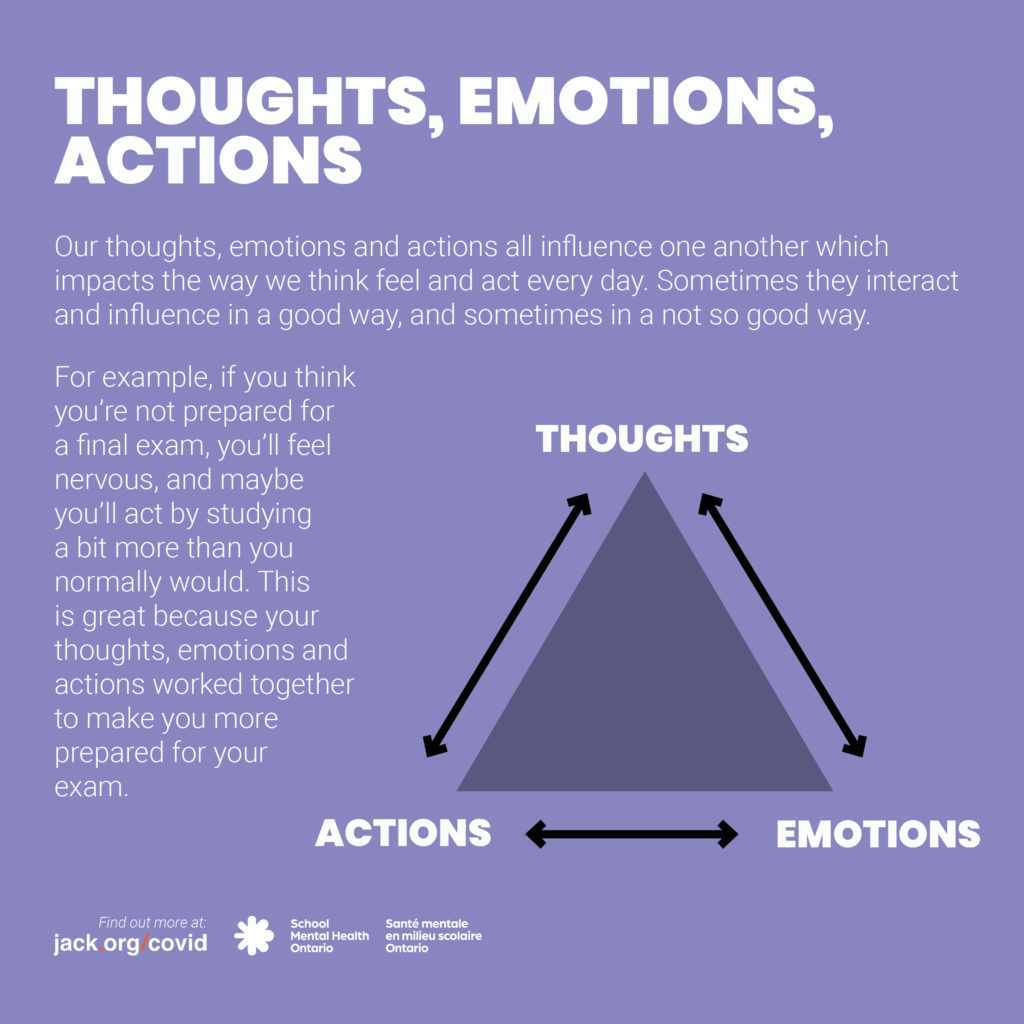
Thoughts, Emotions, Actions
The image contains a triangle diagram. “Thoughts”, “emotions”, and “actions” are each written at one corner of the triangle. Double ended arrows run along the sides of the triangle, connecting the words at each corner.
The text on the image reads:
Our thoughts influence our emotions, our emotions influence our actions and our actions influence our thoughts. Sometimes, our thoughts influence our emotions and actions in a good way.
For example, if you think you’re not prepared for a final exam, you’ll feel nervous, and maybe you’ll act by studying a bit more than you normally would. This is great because your thoughts, emotions and actions worked together to make you more prepared for your exam
Distraction exercises
Download the complete distraction exercises bundle (zip file)
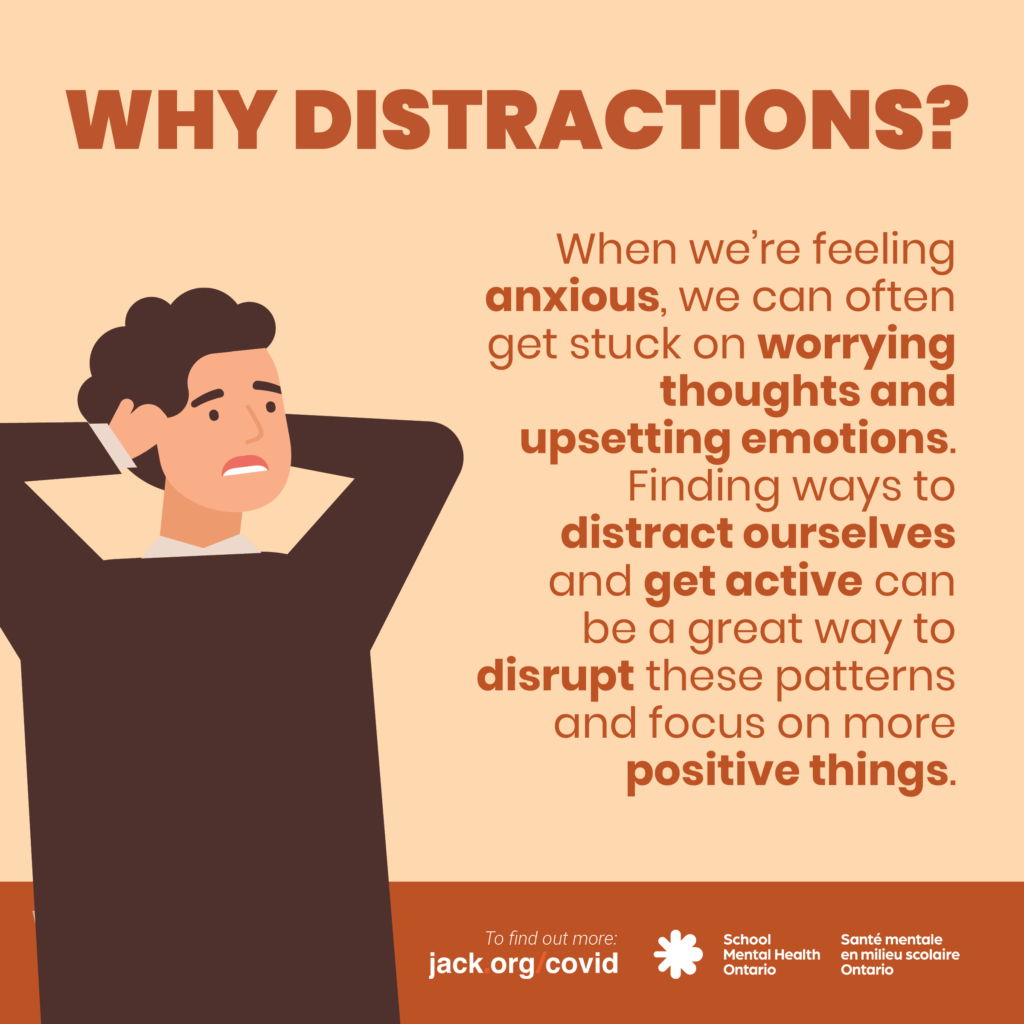
Why distractions?
When we’re feeling anxious, we can often get stuck on worrying thoughts and upsetting emotions. Finding ways to distract ourselves can be a great way to disrupt these patterns and focus on more positive things.
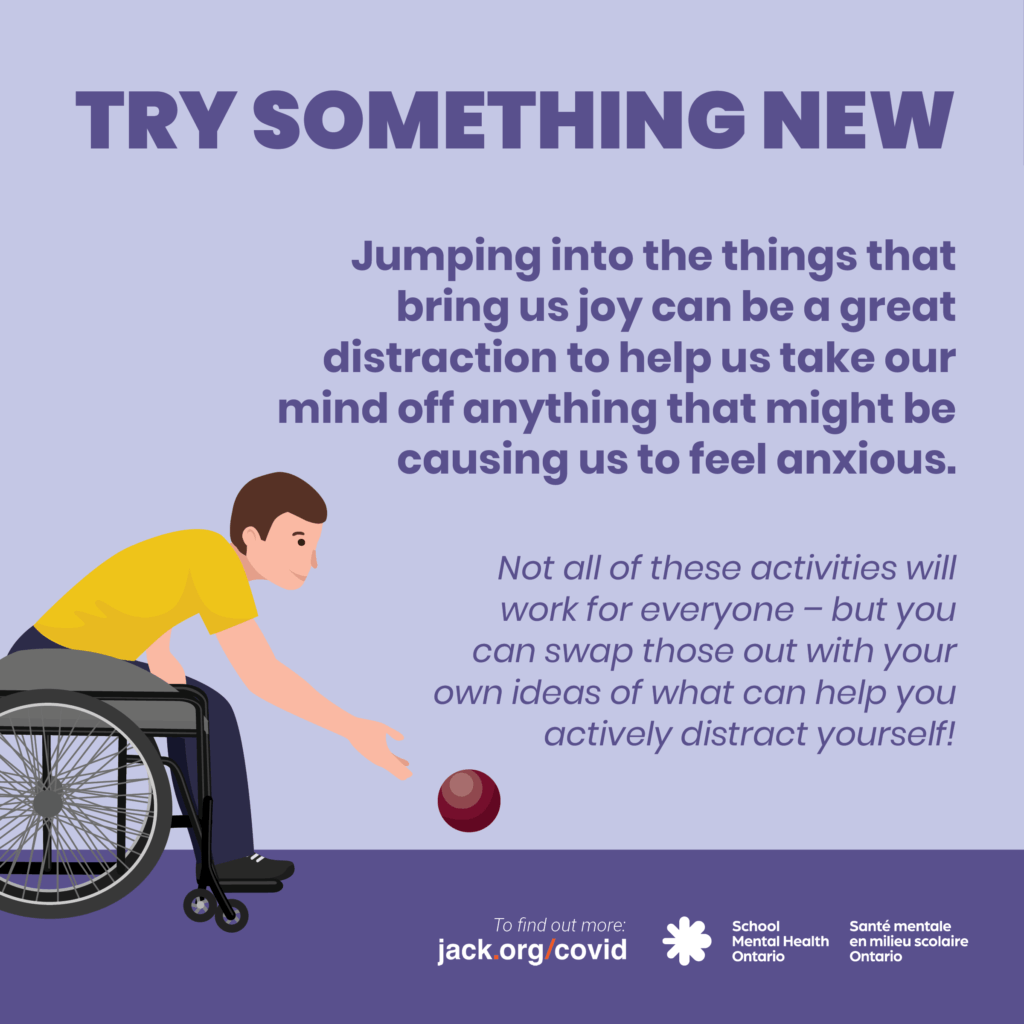
Try something new
Jumping into the things that bring us joy can be a great distraction to help us take our mind off anything that might be causing us to feel anxious.
Not all of the activities listed in the next image and related text will work for everyone – but you can swap those out with your own ideas of what can help you actively distract yourself!

Have you thought about:
starting an art project;
trying a new TV series;
going for a (physically distant) walk or run;
fixing up your space;
starting a new book or re-reading your favourites;
trying an online exercise class;
listening to music;
playing card games;
cooking or baking;
taking a shower or bath;
trying some DIY activities from YouTube;
listening to a podcast or audiobook;
calling a friend or family member;
playing a game with friends on-line;
trying creative writing;
going fishing;
dancing;
other ideas? Try them out!
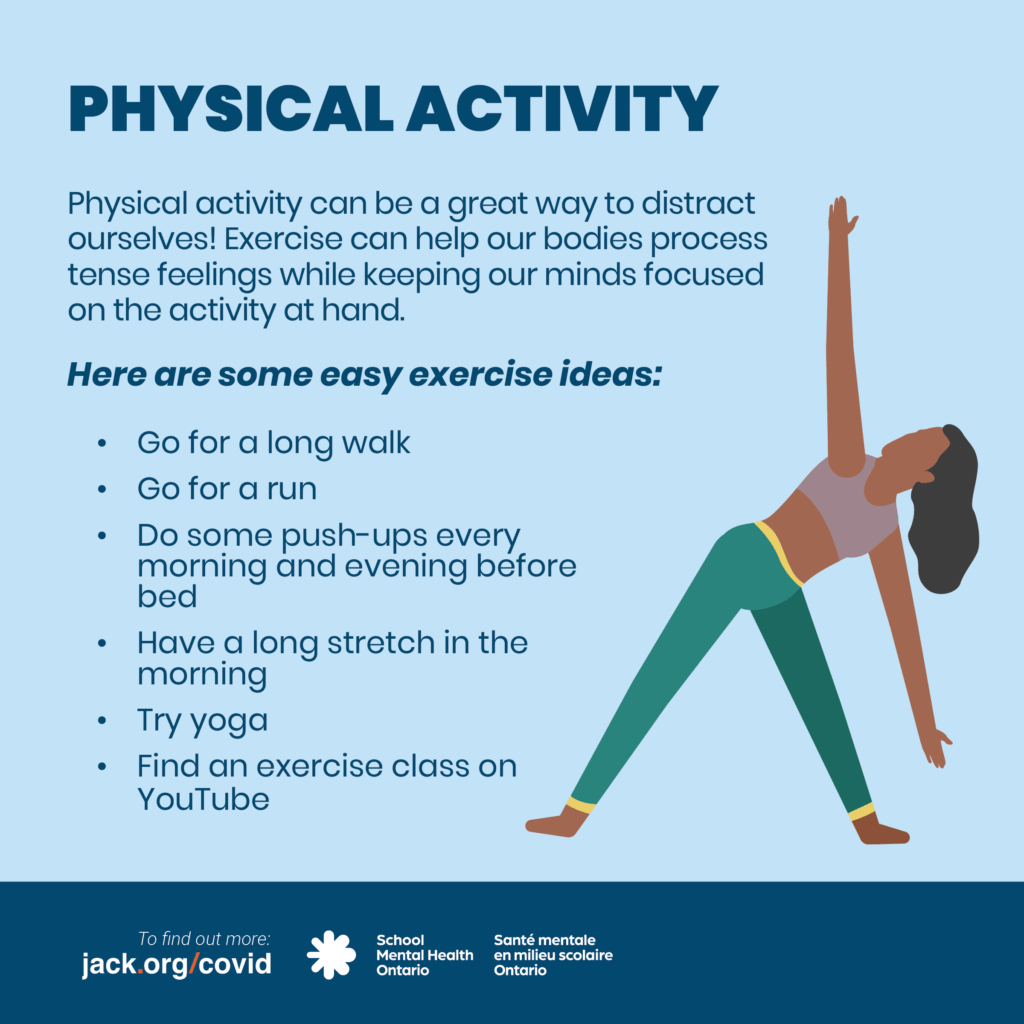
Physical activity
Physical activity can be a great way to distract ourselves! Exercise can help our bodies process tense feelings while keeping our minds focused on the activity at hand.
Here are some easy exercise ideas:
go for a long walk;
go for a run;
do some push-ups every morning and evening before bed;
have a long stretch in the morning;
try yoga;
find an exercise class on YouTube.
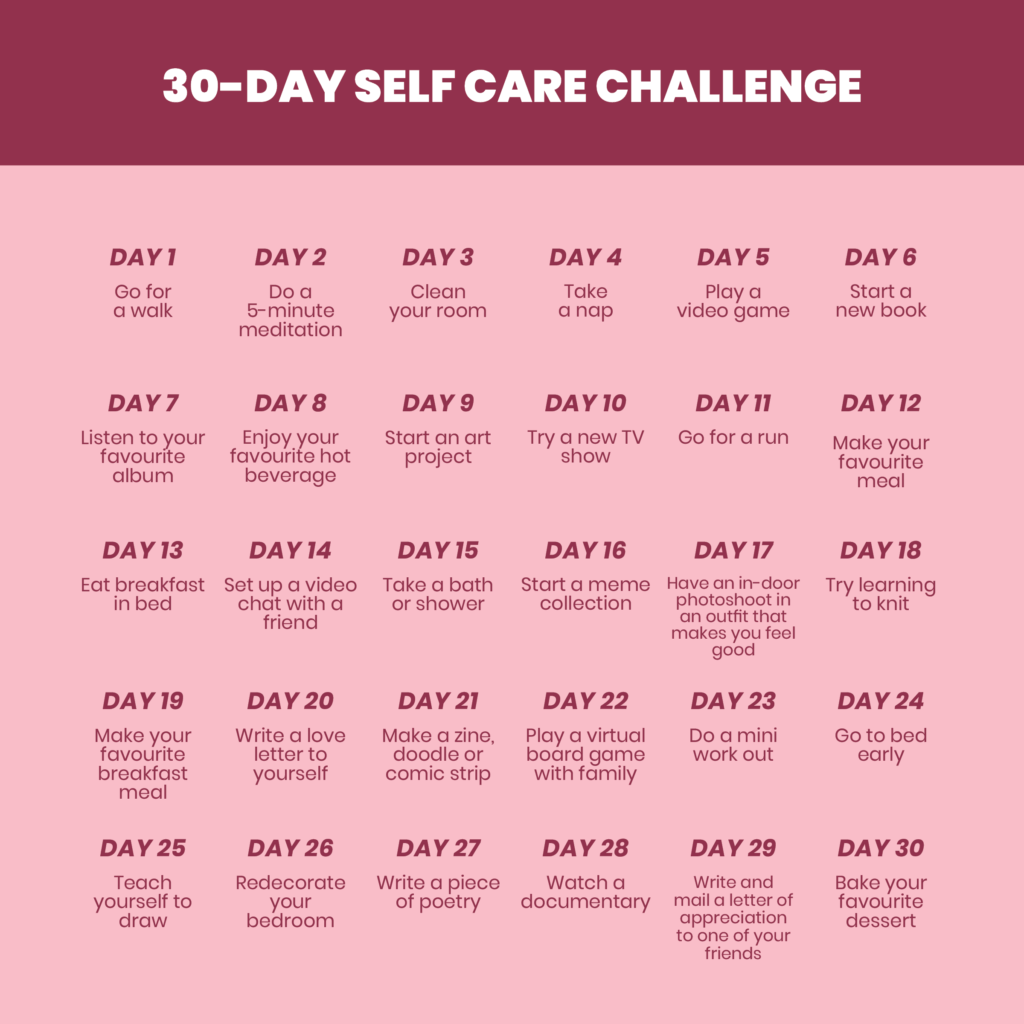
30 Day Self-Care Challenge
Day 1: Go for a walk
Day 2: Do a 5 minute meditation
Day 3: Clean your room
Day 4: Take a nap
Day 5: Play a video game
Day 6: Start a new book
Day 7: Listen to your favourite album
Day 8: Enjoy your favourite hot beverage
Day 9: Start an art project
Day 10: Try a new TV show
Day 11: Go for a run
Day 12: Make your favorite meal
Day 13: Eat breakfast in bed
Day 14: Set up a video chat with a friend
Day 15: Take a bath or shower
Day 16: Start a meme collection
Day 17: Have an indoor photoshoot in an outfit that makes you feel good
Day 18: Try learning to knit
Day 19: Make your favourite breakfast meal
Day 20: Write a love letter to yourself
Day 21: Make a zine, doodle or comic strip
Day 22: Play a virtual board game with family
Day 23: Do a mini work out
Day 24: Go to bed early
Day 25: Teach yourself to draw
Day 26: Redecorate your bedroom
Day 27: Write a piece of poetry
Day 28: Watch a documentary
Day 29: Write and mail a letter of appreciation to one of your friends
Day 30: Bake your favourite dessert
Guided video series for students
Download the guided video series (zip file)
In an animated cartoon, a woman sits cross-legged on the floor in her home.
NARRATOR: Before we get started, find somewhere comfortable and quiet where you can sit or lie down throughout this exercise. Begin by closing your eyes and taking a deep breath.
The woman closes her eyes and takes a deep breath.
NARRATOR: Hold your breath for a moment, pause, and then slowly release the breath.
She releases her breath.
NARRATOR: Imagine yourself in the middle of a forest.
The walls around the woman transform into a forest. She sits peacefully cross-legged on the forest floor, surrounded by tall, lush trees and a tranquil lake.
NARRATOR: If it helps, picture the last forest you were in or the forest from your favourite movie. With your eyes closed, imagine the tall trees surrounding you. Imagine their branches covered in bright green leaves with a little bit of morning dew left on them glistening in the warm sun. A fresh breeze blows through the forest as you take a deep breath. You can feel the fresh forest air filled with the scent of pine needles and maple leaves as you hold your breath in. Slowly breathe out and imagine all of your anxious feelings rushing out of you as you let yourself relax and enjoy the nature you are surrounded by.
Beams of sunlight illuminate the forest and lake behind the woman.
NARRATOR: Listen to the sounds of the forest. You can hear the birds as they chirp to one another, the leaves as they rustle in the wind. Listen to everything happening around you. What do you hear? Can you hear the squirrels running around and the dried leaves crinkling on the forest floor? Let yourself be immersed in the sounds of the forest. Imagine the tension leaving your body. You can feel your shoulders relaxing and the tension flowing out from your fingertips. Let your body relax, let your body enjoy a moment of peace.
Dense vegetation grows amongst the tall trees. In the distance sits the tranquil lake.
NARRATOR: Embrace the peace of the nature you are surrounded by. Imagine the sounds of the forest, the feeling of the light breeze against your skin as it makes the leaves rustle around you and the smell of the plants on the forest floor. What else do you hear? What do you see? How do you feel?
The woman continues to sit with her eyes closed.
NARRATOR: When you are feeling anxious, when you can feel tension building in your brain and your body, remind yourself of the forest. Imagine the sounds, the smells, and the feelings.
The woman is returned to her home as she continues to meditate.
NARRATOR: Letting ourselves relax and enjoy an imaginary moment in the forest can make a big difference and help us release anxious feelings.
LOGO: School Mental Health Ontario.
LOGO: Wisdom 2 Action.
TEXT ON SCREEN: Find out more at smho dash smso dot ca.
TEXT ON SCREEN: Scripted Breathing Exercise.
In an animated cartoon, fluffy white clouds begin to dissipate against a blue sky.
NARRATOR: Clear your mind and focus on the circle.
A circle appears in the center of the screen. A line traces the circumference of the circle as the numbers one, two, three, four appear in succession inside the circle.
NARRATOR: Take a deep breath with me, slowly counting to four as you breathe in. Hold your breath in with me for four seconds. One, two, three, four.
The line disappears as the numbers one, two, three, four appear in succession inside the circle.
NARRATOR: Slowly breathe out for four seconds. One, two, three, four.
The line retraces the circumference of the circle as the numbers one, two, three, four appear in succession inside the circle.
NARRATOR: Breathe in, one, two, three, four. Hold it, one, two, three, four.
The line disappears as the numbers one, two, three, four appear in succession inside the circle.
NARRATOR: Breathe out, one, two, three, four.
The line retraces the circumference of the circle as the numbers one, two, three, four appear in succession inside the circle.
NARRATOR: Breathe in, one, two, three, four. Hold it, one, two, three, four.
The line disappears as the numbers one, two, three, four appear in succession inside the circle.
NARRATOR: Breathe out, one, two, three, four.
The line retraces the circumference of the circle as the numbers one, two, three, four appear in succession inside the circle.
NARRATOR: One last time. Breathe in, one, two, three, four. Hold it, one, two, three, four.
The line disappears as the numbers one, two, three, four appear in succession inside the circle.
NARRATOR: Breathe out, one, two, three, four. You can repeat this exercise as many times as you need.
LOGO: School Mental Health Ontario.
LOGO: Wisdom 2 Action.
TEXT ON SCREEN: Find out more at smho dash smso dot ca.
In an animated cartoon, a wide-angle view shows a man wearing a tank top and shorts. He stands in a park next to a bench. A silhouetted metropolis towers in the distance. The view slowly pushes forward.
NARRATOR: Clear your mind as best you can, and follow along with me. We’re going to start with a long, deep breath. Slowly breathe in through your nose and count to four.
The man inhales.
NARRATOR: One…two…three…four. Now, hold it in for one…two…three…four
The man exhales.
NARRATOR: And breathe out through your mouth…one…two… three…four…Let’s do that again. Slowly breathe in through your nose and count to four with me.
The man inhales.
NARRATOR: One…two…three…four. Now, hold it in for one…two…three…four.
The man exhales.
NARRATOR: And breathe out through your mouth…one…two… three… four… Throughout this exercise, keep taking deep breaths, in through your nose, and out through your mouth.
The view is now a close up on the man’s face. He has a slight grin and stares without blinking.
NARRATOR: Starting at your head, gently scan down through your body. Let yourself notice the different sensations. Notice what feels comfortable and what feels uncomfortable. Not moving or trying to change anything, just noticing.
The view zooms in close to the man’s blue eyes then pans down to his neck.
NARRATOR: Slowly work your way through your body. Notice the sensations in your ears and in your neck. What do you feel? Is there pain, tension or something else? Acknowledge it.
He exhales.
NARRATOR: Slowly breathe out and imagine all of the tension leaving your body.
The view pans lower, focusing on the man’s shoulders.
NARRATOR: Now, work your way downwards. What do you feel in your shoulders? Acknowledge those feelings. Gently breathe through any discomfort.
The view continues to move down, finally reaching the man’s shoes.
NARRATOR: Continue this exercise, checking in with your arms, your chest and your stomach. Work your way all the way down to your toes.
The man continues to stand in the park. He inhales.
NARRATOR: When you are done, take a deep breath for four seconds. Hold it in for four seconds.
The man exhales.
NARRATOR: Now, slowly breathe out and imagine all of the tension leaving your body.
LOGO: School Mental Health Ontario.
LOGO: Wisdom 2 Action.
TEXT ON SCREEN: Find out more at WWW dot SMHO dash SMSO dot CA.
TEXT ON SCREEN: Tense and Relax.
In an animated cartoon, an ariel view of a grassy park slowly spins. A person lying on a blue and white checkered blanket comes into view.
NARRATOR: Over the next few minutes, we’re going to work our way down our bodies, slowly tensing and relaxing each of our muscles. We know that all of our bodies work in different ways. So don’t worry if you can’t do every part of this activity, or if you need to adjust parts of it to make it work for you. Now, before we start, find somewhere flat and comfortable to lie down. We’re going to start with our shoulders. Raise your shoulders all the way up to your ears, as if you were hiding inside a turtle shell.
The person raises and holds their shoulders up.
NARRATOR: Hold them there with me for one, two, three, four seconds. Relax your shoulders, and breathe out.
The person relaxes their shoulders.
NARRATOR: And count with me again. One, two, three, four.
The person raises and holds their shoulders up as the aerial view slowly pushes in closer.
NARRATOR: Raise your shoulders again, all the way up to your ears, hold them there and count with me to four. One, two, three, four.
The person relaxes their shoulders.
NARRATOR: Relax your shoulders. Noticing the difference in how they feel. One last time, raise your shoulders and count with me.
The person raises and holds their shoulders up.
NARRATOR: One, two, three, four. Let them relax. Feel the tension leaving them as we count.
The person slowly relaxes their shoulders.
NARRATOR: One, two, three, four. Take a moment. Remember the tension you felt in your shoulders before? Check in with how they feel now. We all too often hold tension in our bodies without noticing it. This exercise lets us notice that tension and helps our bodies let go of it. Now, we’re going to repeat this exercise with your left bicep.
The view focuses in on the person’s left bicep.
NARRATOR: Flex your left bicep as much as you can.
While still lying down, the person bends their elbow at a ninety-degree angle.
NARRATOR: Hold it for one, two, three, four.
The person relaxes their bicep as the view slowly zooms in closer to their arm.
NARRATOR: Relax your bicep. Pause with me and notice the tension leaving your arm. Notice how different it feels from before. Flex your left bicep again.
The person bends their elbow at a ninety-degree angle.
NARRATOR: Hold it for one, two, three, four. Let it relax.
The person relaxes their bicep as the view slowly widens.
NARRATOR: How does it feel? Can you notice a difference between how it feels now and how it felt before this exercise? One last time.
The person bends their elbow at a ninety-degree angle.
NARRATOR: Flex your bicep, hold it for one, two, three, four seconds. Let it go.
The person relaxes their bicep, lowering their arm towards their waist. Meanwhile, the aerial view slowly widens.
NARRATOR: Notice the tension leaving your arm. Let yourself feel it. You can continue this exercise, slowly working your way through every part of your body from the top down. At each stage, flex or tighten the body part for four seconds, noticing the tension, then relax it for four seconds, paying attention to the tension leaving your body. Repeat three times with each body part.
The view cuts to a close up of the person’s upper body then slowly moves towards their feet.
NARRATOR: Work your way down, starting with your shoulders, moving onto your arms, and then your chest, your stomach, your fists, your butt, your thighs, your calves, and finally your toes. Once you are done, take a moment to check in with yourself and your body. Can you feel the difference? Can you feel the difference in the amount of tension you’re holding in your muscles?
The view slowly pushes out to a wide shot of the person lying on the blanket, surrounded by green grass.
NARRATOR: You can repeat this exercise every day to help remove tension from your body. We often keep ourselves tense when we’re feeling anxious, and exercises like this are a good way to help our bodies and our brains relax.
LOGO: School Mental Health Ontario.
LOGO: Wisdom2Action.
TEXT ON SCREEN: Find out more at WWW dot SMHO dash SMSO dot CA.
You may also be interested in: Equity and Allyship Social Media Bundles

